#15th c. holy Roman Empire
Text

Effigy depicting Anna of Poland, Countess of Celje (died 1425)
#15th century#effigy#sculpture#15th c. sculpture#Bohemia#15th c. bohemia#holy roman empire#15th c. holy Roman Empire#early 15th century#mdpsculpture#1420s#medieval
119 notes
·
View notes
Text

Richard van Bleeck - Portrait of Sir John Holt - ca. 1700
oil on canvas, height: 124.5 cm (49 in) Edit this at Wikidata; width: 99.7 cm (39.2 in)
National Portrait Gallery, London, UK
Sir John Holt (23 December 1642 – 5 March 1710) was an English lawyer who served as Lord Chief Justice of England from 17 April 1689 to his death. He is frequently credited with playing a major role in ending the prosecution of witches in English law.
Historian John Callow argues in his 2022 book, The Last Witches of England, that sceptical jurists, especially Holt, had already largely stopped convictions for witchcraft under English law even before the Witchcraft Act 1735 finally concluded such prosecutions. Callow particularly credits Holt with great courage in doing so in the face of religious pressure, mob violence, and popular superstitious belief in witchcraft.
The Witchcraft Act 1735 (9 Geo. 2. c. 5) was an Act of the Parliament of the Kingdom of Great Britain in 1735 which made it a crime for a person to claim that any human being had magical powers or was guilty of practising witchcraft. With this, the law abolished the hunting and executions of witches in Great Britain. The maximum penalty set out by the Act was a year's imprisonment.
It thus marks the end point of the witch trials in the Early Modern period for Great Britain and the beginning of the "modern legal history of witchcraft", repealing the earlier Witchcraft Acts which were originally based in an intolerance toward practitioners of magic but became mired in contested Christian doctrine and superstitious witch-phobia. Instead of assuming as the earlier laws did that witches were real and had real magical power derived from pacts with Satan, the new law assumed that there were no real witches, no one had real magic power and those claiming such powers were cheaters extorting money from gullible people.
The law was reverting to the view of the primitive and the medieval Church, expressed from at least the 8th century, at the Council of Paderborn, but contested by witch-phobic Dominican Inquisitors beginning in the mid 15th century, with some success in forwarding a new doctrine among the popes, as seen in the papal bull Summis desiderantes affectibus (1484), but with far less success among the bishops. Thus the Act of 1735 reflected the general trend in Europe, where after a peak around 1600, and a series of outbursts in the late 17th century, witch-trials quickly subsided after 1700. The last person executed for witchcraft in Great Britain was Janet Horne in 1727.
In the early modern period, witch trials were seen between 1400 and 1782, where around 40,000 to 60,000 were killed due to suspicion that they were practicing witchcraft. These trials occurred primarily in Europe, and were particularly severe in some parts of the Holy Roman Empire. Some witch-hunts would last for years, and some sources estimate 100,000 trials occurred. Groundwork on the concept of witchcraft (a person's collaboration with the devil through the use of magic) was developed by Christian theologians as early as the 13th century. However, prosecutions for the practice of witchcraft reached a high point only from 1560 to 1630 during the Counter-Reformation and the European wars of religion, with some regions burning at the stake those who were convicted, of whom roughly 80% were women, mostly over the age of 40.
Richard van Bleeck (1670–1733) was a Dutch Golden Age painter.
19 notes
·
View notes
Photo
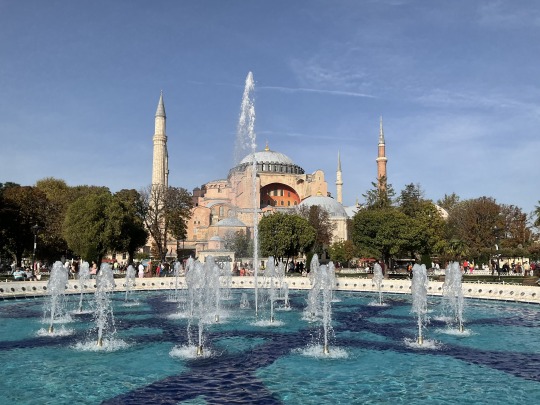


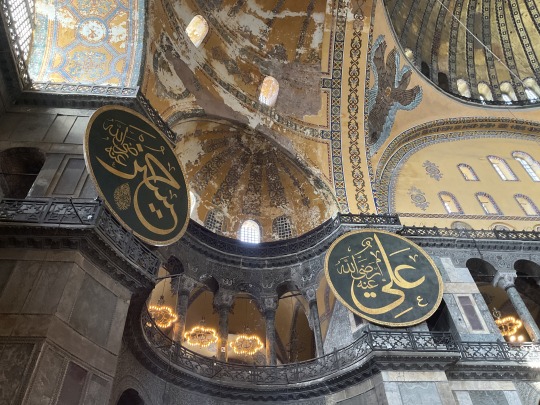


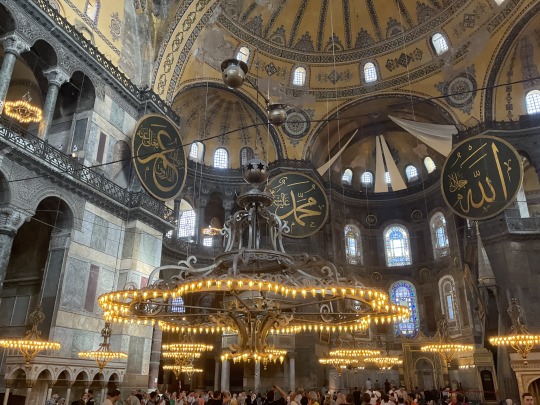
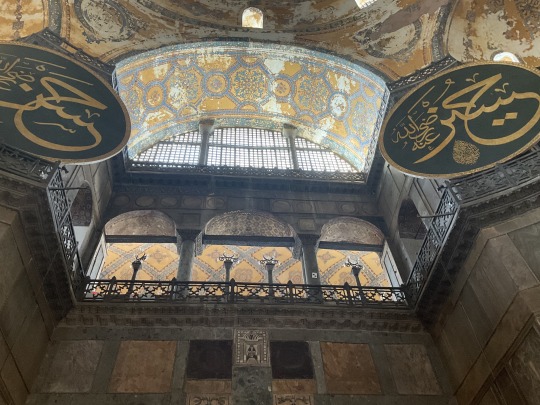


Istanbul: Hagia Sophia was built in 537, with minarets added in the 15th–16th centuries when it became a mosque.
Byzantine Christian cathedral (c. 360–1204, 1261–1453)
Latin Catholic cathedral (1204–1261)
Mosque (1453–1935)
Museum (1935–2020)Mosque (2020–present)
Originally built by the eastern Roman emperor Justinian I as the Christian cathedral of Constantinople for the state church of the Roman Empire between 532 and 537, and designed by the Greek geometers Isidore of Miletus and Anthemius of Tralles, it was formally called the Church of the Holy Wisdom, and was then the world's largest interior space and among the first to employ a fully pendentive dome. It is considered the epitome of Byzantine architecture and is said to have "changed the history of architecture".
0 notes
Note
In a post on the WWC blog, you offered some sources on non-binary and trans people in Late Antique and medieval Europe and the Eastern Roman (Byzantine) Empire to the OP of that post they commented, but while I'm not the OP, I was wondering if I could see those resources if possible? Thanks for your time!
Non-Binary and Trans Identity in Late Antique and Medieval Europe and the Eastern Roman Empire
“According to nature I am a woman, but not according to my thoughts.”
- Amma Sara, desert Christian ascetic c.5th Century CE
In this post:
- an introduction to gender non-conformity in this time period and place (mostly on ascetics, eunuchs, and an intro to Christian theology on absence of gender in human nature)
- a list of gender non-conforming AFAB saints.
- a list of further reading subdivided by topic (including later medieval and some western european sources)
In early Christianity, there was a belief that one could become closer to God by becoming ‘above gender’ (like God, who is without gender). Similarly, when one went off to become an ascetic in the desert, one sought to live the ‘angelic life’, also with strong genderless connotations. This sometimes manifested in obfuscating gender, partaking in gender roles coded as belonging to a different gender, and also living life as a different gender to one assigned at birth.
Lots of accounts of people who lived this way are preserved in hagiography – lives of saints, where some of them are filled with more fantastical details (as in the life of Thecla), whilst others are quieter and with less grand narratives. The fantastical side to these stories might also be of use to tumblr people here though, since the original asker this post is in response to was interested in the intersection between trans, non-binary, third gender people, and magic.
On the topic of third gender and magic, I recommend looking into the history of eunuchs. Eunuchs feature in many cultures, but here I’m only going to talk about them in an Eastern Roman context (during the 'Byzantine' Empire, so about 4th-15th century). In Eastern Roman society, eunuchs were recognised as a third gender – they wore their clothes and hair differently, ate differently, were prescribed different medicines and diets by physicians, and could inhabit different spaces in society. This latter point is especially important, since eunuchs were seen as occupying a liminal and often angelic role in society, and were sometimes associated with holy or magical occurrences. There was also a lot of persecution and denigration of them too. I will link Ringrose’s book at the bottom of this post, as she’s done a very comprehensive study on eunuchs in the Eastern Roman Empire.
In terms of ascetics who chose to live as another gender, a lot the records we have of people who chose this life are those who were assigned female at birth. There’s rightly been some critical study of the portrayal of this in sources, since there has sometimes been a religious rhetoric of ‘womanhood’ being something that is lesser than a ‘spiritual maleness’ which was sometimes encouraged. And this is contextualised by a host of social situations that might encourage a woman to escape her station in life, either to get out of a marriage or to flee from some other pursuit or expectation put on her. A lot of scholarship however has neglected to mention two important things: 1) Regardless of cultural context or reason, lots of the people in these sources identified as male, took a male names, pronouns, lives as monks, sometimes in male monastic communities, were almost only ever outed against their will, and frequently requested to be buried and remembered as male. It is frankly insulting not to respect the wishes of these men to be remembered as such. 2) There was a Christian theological tradition of eschewing or obfuscating gender in order to draw closer to the divine, and it's also insulting not to respect the sincerity of these people in their choices to become an ascetic. Perhaps some of them did choose for some social reasons to “hide” in a monastery, but it insults the intelligence and spiritual sincerity of these saints not to acknowledge that there were spiritual reasons for wanting to live their gender in a different manner. It’s worth remembering that these records are of saints - people who were considered to have lived such a holy life that they are remembered as paragons of Christian living and intercessors for those to come. Essentially, some scholarship is very quick to say these are persecuted ‘women’, when the saints themselves tell us they are men and that the choice to identify as such is related to their faith.
It's also worth bearing in mind that being an ascetic of any kind can be seen as being a different ‘gender’. Maleness in Eastern Roman society was especially dictated by social customs such as being the head of a household, being sexually active, wearing hair and clothes in a certain way, partaking in the public sphere in a certain way – and part of Christian asceticism is a deliberate removal from this kind of citizenship and practice of gender. So it's important to bear in mind that the kind of trans identity, non-binary identity and agender identity of ascetics in early Christianity is not something that can easily map onto our own understandings of gender today. Indeed, a division into sex and gender is already anachronistic to Late Antiquity, since they were perceived as a single thing and also tied into many other factors in Eastern Roman society. I think contemporary terms like transgender are still some of the best we can use though, firstly because they give us a continuous queer history that we’re often denied as trans people today, and secondly because they much better reflect the lived experiences of these historical people than the terms used in current academic literature (‘cross-dressing’ and ‘transvestite’ are used, ignoring that someone who lives 50 years as a man and died asking to still be called one is not ‘cross-dressing’ as a man). The kind of maleness of a monk though, trans or cis, is quite different from the maleness of a Byzantine male citizen (or of a eunuch citizen).
In terms of the theology behind this Christian understanding of gender, it especially takes as its touchstone Paul’s words that there is no male or female in Christ (Gal. 3:28), and also Christ’s words that there there will be no marriage after the resurrection (Matt 22:30). St Gregory of Nyssa, St Macrina the Younger (Gregory’s sister), and St Maximus the Confessor, all exceptionally important early Church theologians, developed a more robust theology of gender in order to understand how these statements fitted in with the Genesis story of human creation. I will link to a more full explanation in articles below, but the short-hand is that they believed that the human being was originally created without any sexed or gendered characteristics. Sex and gender were introduced after the fall in order that a physical kind of procreation would be possible (prior to the fall, some kind of immaterial reproduction was thought to maybe occur). Theologians like Maximus thought that your sex and gender could be important, but only because you made them an important part of your holy journey towards communion with God. (The end hope for all creation in early Christian Greek thought is participation in God, ‘deification’ or ‘theosis’, where you become God, though a distinction is still maintained between creation and Creator. You participate by grace rather than by essence.) This means that sex and gender are pretty malleable in this kind of theology, and in Maximus’ thought, there is even an implication that one ought to explore one’s gender in a personal and creative way in order harness it to a search for trying to live virtuously.
Not only were humans thought to have been created without sexed characteristics, but they were also believed to be resurrected into a perfect kind of humanity that would also be absent of these characteristics. So the absence of sex and gender was seen as a holy state humans would one day return to. Whilst Gregory and Maximus aren’t in a majority of Christian theologians who held this position, they were exceptionally influential, especially in monastic movements. To see this kind of theology in action, it's worth reading Gregory’s ‘Life of Macrina’, a short read easily available in English translation. In it, he wonders if his sister can really be called a woman any more, since she has somehow overcome the genders of fallen human nature because she’s so holy. He also obfuscates gendered language around her to show this, calling her both a mother and father to their younger siblings, talking about her ‘manly’ characteristics in not lamenting, and using mixed Greek grammar when he calls her “the teacher” (hē didaskalos) - using a female particle with the male noun. This obfuscation of language is a big part of Gregory’s theology when he talks about God too. He is famous for his ‘apophatic’ language – trying to express that holiness is beyond words and comprehensibility by using paradoxes of language. So the way he talks about his sister overcoming gender directly parallels the way he talks about the unknowability of God as Macrina draws close to the divine.
Okay so this has mostly been about early Christian theology especially in the Eastern Roman Empire. Stories particularly of AFAB people who became Christian monks are more widespread than this – both predating the Eastern Roman Empire, and post-dating it and extending into what we now think of as Europe today as well. I will provide a list of some of the lives of these saints below and key details about them, because whilst you may want to do your own research, it is a very transphobic field of study and can be difficult to stomach.
My knowledge outside of the above area is limited, but I’ve been lucky enough to get to know many medieval scholars who work especially on trans and non-binary themes in medieval literature, especially old French and Norse literature as well as accounts of gender non-conforming holy people in the British Isles. I will provide links to their research below too. There are lots of literary tales for example of knights who, before they put on armour, held positions as princesses, and then go on to have romantic entanglements with other knights, or princesses, or have crises of identity or debate their own gender and possible fluidity of gender, so plenty of resources out there on European-centric themes of breaking gender binary (especially since that binary didn’t even exist in mainstream society much of the time, for example with eunuchs and ascetics).
List of Gender Non-Conforming Saints in Late Antique & Medieval Europe & the Eastern Roman Empire
Here is a list I’ve compiled from Butler’s Lives of the Saints. This was an 18th century English collection of translated hagiographical notes, full of ‘colourful’ (transphobic) editor notes woven into the retellings of the original stories (many of which are spread across different manuscripts). It was republished in four abridged volumes in 1990, apparently with some of those colourful additions removed, so I dread to think what the original was like. Below are my notes which are a bit fragmentary, but bulletpoint what I thought to be the key areas of interest. This is a list of most of the gnc saints I could find in the volume, including those who only put on men’s clothes for a day, or grew a beard to put off a suitor. I put in strikethrough their deadnames, which are provided because that’s annoyingly how you will find them listed in all academic sources. Direct quotations retain incorrect pronouns. In my own notes I try to use the saints’ pronouns of choice or a gender neutral ‘they’ when it’s more ambiguous what they may have wished. Please also note the direct quotations include transphobic language such as use of the terms of ‘disguise’ and ‘discovered to be a woman’. There are more saints than this as well, these are just the ones I could find in this particular book.
One additional note: if you aren’t familiar with the genre of hagiography these might come as a shock. A hagiography is a text published after the death of a person (often shortly after, but can be longer) who during their life was a source of piety, wisdom and inspiration. Usually they also have a following after they’ve died of people who pray for the holy person to intercede on their behalf and teach them to become holy people too. So the hagiography is meant to explain to others the miracles the holy person did and how amazing their life was, justifying their recognition as a saint (lots of these were before ‘official canonisation’ by the Church was a thing). They are stories full of miracles that emphasise the piety and spiritual hardships of the person they are about.
Source: Butler’s Lives of the Saints. Thurston, H.J. & Attwater, D. (eds.) Maryland: Christian Classics, 1990 (first published 1756-9)
Smaragdus/Euphrosyne, vol.1 p4 (Fifth Century?) (Feb 11)
“When the interview was over, and Euphrosyne began to think matters out, she came to the conclusion that she could not count upon being safe from her father in any nunnery in that country, for he would be sure to find her and carry her off by force. She therefore secretly changed into man’s attire and slipped out of the house by night – her father being still away.” 4
“No one ever suspected her sex, and she soon gave proof of extraordinary progress in virtue. She had many trials and temptations, but she overcame them all. Because her beauty and charm were a cause of distraction to the other monks, she retired to a solitary cell where she saw only those who desired her advice.” 5
“She recognised him [her father], but he did not know her, since her face was almost hidden and she was much changed by her austerities. She gave him spiritual consolation, but did not make herself known to him till she was on her death-bed many years later.” 5
Dorotheus/Apollinaris, vol. 1 p33 (c. 4th century) (January 5; Pealgia Oct 8)
“[…] Apollinaris who is the daughter of the ‘Emperor’ Anthemius, runs away from home, disguises herself as a man, calls herself Dorotheus, and leads a hermitical life in the desert under the direction of the renowned ascetic, Marcarius.”
charged with sexual misconduct (with own sister) and has to reveal who he is to his own father in order to prove his innocence.
“However, after obtaining her sister’s complete cure by her prayers, she insists on return to the desert where her sex is only discovered by her fellow hermits after her death.”
Marinus/Marina, vol. 1 p313 (no date) (July, vol. iv) (July, vol. iv)
A child brought by their father to the monastery and lived as a boy there.
Later accused of being the father to a child. Was given the child to raise as his own.
The injustice done to Marinus was discovered only when his sex was revealed after his death, 314
Anastasius the Eunuch/Anastasia Patricia, vol.1 p546 (no date) (Egyptian ancestry, lived in Constantinople) (March, vol.ii)
given the habit of a monk in order to flee marriage to Emperor Justinian. Told never to emerge or to let anyone enter. Fled to Alexandrian convent, then fled to the desert when the emperor searched for them.
Lived as “Anastasius the Eunuch” for twenty-eight years, “and in all that time she never beheld the face of man, but gave herself up to prayer and mortification.” 547
“Then the abbot and his disciple buried her in her habit according to the wish she had expressed just before her death.” 547
Joseph/Hildegund, vol.2 p135 (1188 AD) based in Cologne (April, vol. ii)
Lived whole life as ‘Joseph’ at first as a child to protect them whilst riding with their father
continued to use ‘Joseph’ for the rest of their life.
“She received the Cistercian habit and remained at Schoenau until her death, although she made two or three attempts to run away, apparently fearing that her sex would be discovered. She never took vows, but died a novice. Only after her death was it discovered that she was a woman.” 134
Wilgefortis/Liberata/Uncumber vol.3 p151 (no date) (July, vol. v)
prayed for help because she had sworn herself to virginity but was being forced to marry
a beard and moustache grew on her face, so the suitor refused to marry her
her enraged father had her crucified.
Natalia vol.3 p507 (c. 304 AD) (August vol. v p808-11) (pdf 1990)
lived in Nicomedia
cropped her hair, put on men’s clothes briefly in order to gain access to the prison her husband was in.
“Theodora” of Alexandria vol.3 p538 (no date) (September, vol iii) (pdf 2021)
“They relate that she was the wife of Gregory, prefect of Eygpt, and that, having fallen into grave sin, she fled away from her home to expiate it in a monastery of the Thebaid. Disguised as a man she lived for many years among the monks a life of extraordinary austerity.” 538
“[...]St Theodora was accused of being guilty of seduction and was vindicated only after her death.” 538
died in Alexandria
Thecla of Iconium, vol.3 p623 (First Century?) - (pdf page 2106)
versed in philosophy and literature, learned from St Paul
Gregory of Nyssa says that “she undertook the sacrifice of herself by a life dead to the senses, so that nothing seemed to remain living in her but reason and spirit.” 623
broke off her engagement ran off to follow St Paul around. Family and local government were mad.
Thecla was ordered to be burnt but a storm from heaven put out the fire.
she beat up a guy who tried to abduct her
adopted by a queen (this story really has everything)
ordered to be executed in an amphitheatre but the lions had a snooze at her feet instead
threw herself in a ditch and baptised herself. Something about dead seals??
she came out the water in a cloud of fire.
They tried to set bulls on her but she was too on fire.
They released her because her queen friend fainted
Put on men’s clothes and rejoined St Paul. “dressed as a boy” 624
Retired to live in a cave for seventy-two years
did miracles
jealous bandits were sent out to attack her
she prayed and a rock opened up, she walked into it and was never seen again
Galla vol. 4 p36 (550AD, Rome) (October vol iii)
widowed after a year of marriage, decided to become bride of Christ rather than marry again.
“She was not to be turned from her resolve even by the warning of her physicians that if she did not marry again she would grow a beard.” 37
joined a community of holy women.
Pelagius the Beardless Monk/Pelagia vol. 4 p59 (No Date, Antioch) (October, vol. iv) (pdf 2264)
Was an actress with a white donkey and beautiful jewellery
Came to hear St Nonnus’ sermon. Asked him for baptism.
gave up property to the poor, laid aside female garments and put on men’s clothes, disappeared from the city
lived alone in a cave on the mount of olives, where he was known as ‘the beardless monk’
“When those who came to bury her discovered her sex, they cried out ‘Glory be to thee, Lord Jesus, for thou has many hidden treasures on earth, as well female as male.” 60
Athanasia vol 4 p69 (Fifth Century, Egypt (orginally)) (October vol iv) (pdf 2274)
Married to a silversmith named Andronicus in Antioch. Children both died on the same day, spent her(?) days weeping at their graves.
A stranger told her her children were happy in heaven, Athanasia believed this was St Julian the martyr, in whose memory the church was dedicated.
Told her husband and suggested that they renounce the world. Her husband agreed
Made their way to Eygpt and sought out St Daniel in Skete. Daniel sent Andronicus to the monastery of Tabenna and Athanasia to be an anchoress in the wilderness, dressed in the habit of a man. They lived in this way for 12 years.
Andronicus came to know a beardless monk called Athansius, they travelled together and had great affection for each other and didn’t want to be parted. Went to an Alexandrian monastery where they were given cells near to each other.
When it was time for Athanasius to die, he wept because he knew Andronicus would miss him. But said ‘give him the writing under my pillow when I am dead’. Andronicus read it and realised that Athanasius had previously been his wife Athanasia.
Andronicus died shortly after and was buried next to Athanasius.
“Eugenia” vol. 4 p612 (Alexandria, No Date) (Migne PL vol xxi and lxxiii; Migne PG vol cxvi, p609-52)
‘daughter’ of duke of Alexandria, went to live in an abbey in a man’s habit.
Led so holy a life there that they made him an abbot
no one there knew his birth sex, and a lady accused ‘Eugenia’ of adultery before a judge (the judge was Eugenia’s father).
Eugenia was put in prison and condemned to death.
“At the last she said to her father much thing for to draw him to the faith of Jesus Christ. She rent her coat and showed to him that she was a woman and daughter of him that held her in prison, and so she converted her father unto the Christian faith.” 612
Eugenia made many converts and was eventually martyred
apparently the false accusation was prompted by Eugenia repelling the advances of a woman whom he had miraculously cured of sickness.
Further Reading
This field is a very live topic of debate and some of the articles I want to put here aren’t published yet, so I will update this post in about a year’s time when you can read more of this stuff in print. Some authors on this list are trans and nb scholars themselves, whilst others are noticeably not and use very questionable language to talk about these topics (I’ve left off the really old bad ones). I know someone doing Norse literature and gender studies, so I will ask them for a reading list on that, but I haven’t included anything on it below.
Send me an ask if you need help getting any of these, I might be able to help you out.
General
Alicia Spencer-Hall, Blake Gutt (eds.), Trans and Genderqueer Subjects in Medieval Hagiography. (Amsterdam University Press, 2021).
D. Campanile, F. Carlà-Uhink, & M. Facella (eds.) TransAntiquity: Cross-Dressing and Transgender Dynamics in the Ancient World. (London: Routledge, 2017).
Gabrielle M.W. Bychowski, “Trans Metamorphoses and Identity: Medieval Taxonomies of Transgender and Transitioning,” More Fuss About the Body: New Medievalists’ Perspectives. Leah Parker & Stephanie Grace Petinos, ed. (2021).
Gabrielle M.W. Bychowski, “Trans” Companion to Sexuality in the Medieval West, Michelle Sauer ed. (ARC Humanities Press, 2021).
B. Neil & L. Garland (eds.) Questions of Gender in Byzantine Society. (London: Routledge, 2013).
François·e Charmaille, ‘Intersex Between Sex And Gender In Cause Et Cure’ Exemplaria. 33, 4 (2021): 327-343.
S. Constantinou and M. Meyer (eds.) Emotions and Gender in Byzantine Culture. (Palgrave Macmillan 2019).
A full list of Dr Bychowski’s work can be found here and may be of interest: http://www.thingstransform.com/p/publications.html
Asceticism
Claudia Rapp, Brother-making in Late Antiquity and Byzantium: Monks, Laymen, and Christian Ritual (OUP, 2016).
N. Mylonas, ‘Erasing Alterity: Gendered Characterization in the Different Versions of Vita Anastasiae’. Journal of Australian Early Medieval Association 13 (2017): 19-46.
The Sayings of the Desert Fathers: The Alphabetical Collection. Benedicta Ward (trans.) Oxford: Cistercian Publications, 1975.
S.J. Davis, ‘Crossed Texts, Crossed Sex: Intertextuality and Gender in Early Christian Legends of Holy Women Disguised as Men’ Journal of Early Christian Studies 10 (2002): 1-36.
H. Hunt, ‘Chapter 5: Virgins of God: Manly Women and Transvestite Saints’ in Clothed in the Body: Asceticism, the Body and the Spiritual in the Late Antique Era. (London: Routledge, 2012).
Eunuchs
K.M. Ringrose, The Perfect Servant: Eunuchs and the Social Construction of Gender in Byzantium. (London: University of Chicago Press, 2003).
M. Kuefler, The Manly Eunuch: Masculinity, Gender Ambiguity, and Christian Ideology in Late Antiquity. (Chicago: University of Chicago Press, 2001).
Theology
Michael Nausner, ‘Toward Community Beyond Gender Binaries: Gregory of Nyssa’ Transgendering as Part of his Transformative Eschatology’ Theology and Sexuality 16 (2002): 55-65.
Sarah Coakley, ‘The Eschatological Body: Gender, Transformation, and God’ Modern Theology 16:1 (2000), 61-73.
Cameron E. Partridge, Transfiguring Sexual Difference in Maximus the Confessor. (PhD diss., Harvard Divinity School, 2008).
E. Brown Dewhurst, ‘Beyond the Borders of Society: Sex and Gender as Tropos in Maximus the Confessor’s Theology and its Relevance to Contemporary Ethics’ Theology and Sexuality (2022).
E. Brown Dewhurst, ‘The Absence of Sexual Difference in the Theology of Maximus the Confessor’ in Philosophy and Society. 32, 2 (2021): 204-225.
Rowan Williams, “Macrina’s Deathbed Revisited: Gregory of Nyssa on the Mind and Passion.” in Christian Faith and Greek Philosophy in Late Antiquity: Essays in tribute to George Christopher Stead.L.R. Wickham & C.P. Bammel (eds.) Leiden: Brill, 1987.
Medieval French Literature
Blake Gutt, ‘Transgender Mutation and the Canon: Christine de Pizan’s Livre de la Mutacion de Fortune’, postmedieval 11.4, 2020 (10th anniversary special edition, ‘Race, Revulsion, and Revolution’), 451–458.
Blake Gutt, 'Medieval Trans Lives in Anamorphosis: Looking Back and Seeing Differently (Pregnant Men and Backward Birth)', Medieval Feminist Forum 55.1 (2019): 174-206.
Blake Gutt, 'Transgender Genealogy in Tristan de Nanteuil', Exemplaria 30:2 (2018), 129-46.
B. Findley, Poet Heroines in Medieval French Narrative: Gender and Fictions of Literary Creation. (Palgrave Macmillan, 2012).
Kimberlee Campbell, “Acting Like a Man: Performing Gender in Tristan de Nanteuil.” In Cultural Performances in Medieval France: Essays in Honor of Nancy Freeman Regalado, edited by Eglal Doss-Quinby, Roberta L. Krueger, and E. Jane Burns, 79–89: (2007).
Francesca Canadé Sautman, “What Can They Possibly Do Together? Queer Epic Performances in Tristan de Nanteuil.” In Same Sex Love and Desire among Women in the Middle Ages, edited by Francesca Canadé Sautman and Pamela Sheingorn, 199–232. New York: Palgrave: (2001).
Angela Jane Weisl, “How to Be a Man, Though Female: Changing Sex in Medieval Romance.” Medieval Feminist Forum 45 (2): 110–137: (2009).
UPDATED: to include recommendations on Norse topics from a colleague.
Norse Archaeology and Literature
Lee Colwill, “The Queerly Departed: Narratives of Veneration in the Burials of Late Iron Age Scandinavia” in Alicia Spencer-Hall, Blake Gutt (eds.), Trans and Genderqueer Subjects in Medieval Hagiography. (Amsterdam University Press, 2021): 177-198.
Neil Price, The Viking Way: Magic and Mind in Late Iron Age Scandinavia. (CUP: 2002).
Brit Solli, ‘Queering the Cosmology of the Vikings: A Queer Analysis of the Cult of Odin and the “Holy White Stones”’ Journal of Homosexuality 54 (1-2) (2008): 192-208.
Neil Price et al. ‘Viking warrior women? Reassessing Birka chamber grave Bj.581’ Antiquity, 93 (367). (2019): 181-198.
Jóhanna Katrín Friðriksdóttir, ‘'With mirthful merriment': Masquerade and Masculinity in Mágus saga jarls’ in Masculinities in Old Norse Literature. (CUP: 2020): 77-94.
Miriam Mayburd, ‘“Helzt þóttumk ek heima í millim” A reassessment of Hervör in light of seiðr's supernatural gender dynamics” Arkiv for Nordisk Filologi 129 (2014):121-164. (ultimately concludes that we shouldn't read Hervör/Hervarðr as trans, but is probably the most extensive consideration of the possibility).
Short paragraph from my colleague on where to look for primary sources:
In terms of primary texts, obviously anything to do with Loki lends itself very well to questions of gender and embodiment (so that's the Prose Edda and the Poetic Edda (esp Lokasenna and Þrymskviða) as our two main sources for that). I will always plug Hrólfs saga Gautrekssonar for how insistent Þórbergr is that he should be referred to only in male terms from now on, which we don't really see elsewhere. Hervör in Hervarar saga spends a while presenting as male, as does Ermengá in Mágus saga jarls. There's also a really interesting (probably) late-medieval poem called Snjáskvæði where an elf-woman is cursed to appear male in the human realm.
Tags: mentions for those who asked for this post
@bluerosegarden @zombat @elvashayam
#trans history#queer history#non binary history#theology#byzantine history#medieval history#writing reference
228 notes
·
View notes
Note
What makes the 17th century so much worse than, say, the 15th century?
@publiusmaximus
If this is costume-related (I've been off Tumblr for a while and have no idea when this ask came in), the answer for Europe is ruffs and lace.
If this is about The World, the short answer is Death.
It's SO shitty it's referred to as The Crisis of the 17th. c.
The longer answer is climate change, and general shittiness culminating in Deaths from Famine, Plague, and War.
As well as a lot of Miscellaneous Death from fires, witch hunts, massacres/mass murders, Inquisitions, the Dutch East India Company, and expansion of global slave trades (which is Generally Shitty, but associated with a lot of Death.) Most of the "bad things" people associate with the Middle Ages are much, much worse in the 17th c. shitstorm.
Multiple "Great Famines," even more Just Regular Famines (death toll multiple millions)
Multiple "Great Plagues," even more Just Regular Plagues, and some epidemics (including the general epidemic of new diseases wiping out the Americas).
List of 17th c. Health Disasters
LOTS of wars
(including the most religious warfare ever seen in Europe, the Ming-to-Qing transition in China (just a ton of people over most of the century), the troubled expansion of the Mughal Empire under Aurangzeb until it surpassed even the Qing economically, all kinds of shit in the Americas, the Ottomans vs. the Holy Roman Empire and Poland and Russia and the Safavids and whoever else was available that week, and various revolts, rebellions, uprisings, resistance movements, etc. pretty much everywhere.

(Source)
And some miscellaneous deaths.
General Crisis of the 17th c. (details of climate change and the Little Ice Age)
Witch Hunts
Fires
Massacres and mass murders
The Dutch East India Company
Global Slave Trades (which involved a lot of Death, as well as General 17th c. Shittiness)
Link goes directly to Qing China, because there's a LOT, but there have always been forms of slavery throughout Asia (like the rest of the world).
And finally, Russia didn't go "full serfdom" until 1597.
In short, the 17th c. sucked. Everywhere. For everyone.
33 notes
·
View notes
Photo
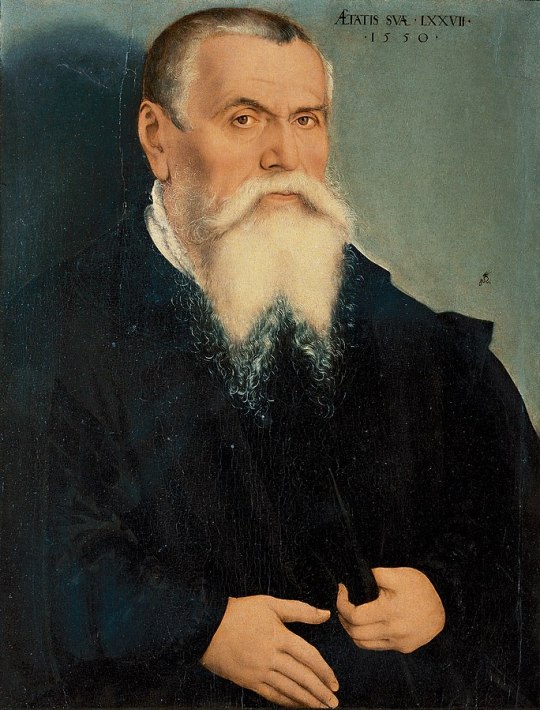
Lucas Cranach the Younger - Portrait of the artist's father, Lucas Cranach the Elder - 1550
Lucas Cranach the Younger (Lucas Cranach der Jüngere; October 4, 1515 – January 25, 1586) was a German Renaissance painter and portraitist, the son of Lucas Cranach the Elder.
Lucas Cranach the Elder (German: Lucas Cranach der Ältere German, c. 1472 – 16 October 1553) was a German Renaissance painter and printmaker in woodcut and engraving. He was court painter to the Electors of Saxony for most of his career, and is known for his portraits, both of German princes and those of the leaders of the Protestant Reformation, whose cause he embraced with enthusiasm. He was a close friend of Martin Luther. Cranach also painted religious subjects, first in the Catholic tradition, and later trying to find new ways of conveying Lutheran religious concerns in art. He continued throughout his career to paint nude subjects drawn from mythology and religion.
Cranach had a large workshop and many of his works exist in different versions; his son Lucas Cranach the Younger and others continued to create versions of his father's works for decades after his death. He has been considered the most successful German artist of his time.
He was born at Kronach in upper Franconia (now central Germany), probably in 1472. His exact date of birth is unknown. He learned the art of drawing from his father Hans Maler (his surname meaning "painter" and denoting his profession, not his ancestry, after the manner of the time and class). His mother, with surname Hübner, died in 1491. Later, the name of his birthplace was used for his surname, another custom of the times. How Cranach was trained is not known, but it was probably with local south German masters, as with his contemporary Matthias Grünewald, who worked at Bamberg and Aschaffenburg (Bamberg is the capital of the diocese in which Kronach lies). There are also suggestions that Cranach spent some time in Vienna around 1500.
From 1504 to 1520 he lived in a house on the south west corner of the marketplace in Wittenberg.
According to Gunderam (the tutor of Cranach's children), Cranach demonstrated his talents as a painter before the close of the 15th century. His work then drew the attention of Duke Frederick III, Elector of Saxony, known as Frederick the Wise, who attached Cranach to his court in 1504. The records of Wittenberg confirm Gunderam's statement to this extent: that Cranach's name appears for the first time in the public accounts on the 24 June 1504, when he drew 50 gulden for the salary of half a year, as pictor ducalis ("the duke's painter"). Cranach was to remain in the service of the Elector and his successors for the rest of his life, although he was able to undertake other work.
Cranach married Barbara Brengbier, the daughter of a burgher of Gotha and also born there; she died at Wittenberg on 26 December 1540. Cranach later owned a house at Gotha, but most likely he got to know Barbara near Wittenberg, where her family also owned a house, which later also belonged to Cranach.
The first evidence of Cranach's skill as an artist comes in a picture dated 1504. Early in his career he was active in several branches of his profession: sometimes a decorative painter, more frequently producing portraits and altarpieces, woodcuts, engravings, and designing the coins for the electorate.
Early in the days of his official employment he startled his master's courtiers by the realism with which he painted still life, game and antlers on the walls of the country palaces at Coburg and Locha; his pictures of deer and wild boar were considered striking, and the duke fostered his passion for this form of art by taking him out to the hunting field, where he sketched "his grace" running the stag, or Duke John sticking a boar.
Before 1508 he had painted several altar-pieces for the Castle Church at Wittenberg in competition with Albrecht Dürer, Hans Burgkmair and others; the duke and his brother John were portrayed in various attitudes and a number of his best woodcuts and copper-plates were published.
In 1509 Cranach went to the Netherlands, and painted the Emperor Maximilian and the boy who afterwards became Emperor Charles V. Until 1508 Cranach signed his works with his initials. In that year the elector gave him the winged snake as an emblem, or Kleinod, which superseded the initials on his pictures after that date.
Cranach was the court painter to the electors of Saxony in Wittenberg, an area in the heart of the emerging Protestant faith. His patrons were powerful supporters of Martin Luther, and Cranach used his art as a symbol of the new faith. Cranach made numerous portraits of Luther, and provided woodcut illustrations for Luther's German translation of the Bible. Somewhat later the duke conferred on him the monopoly of the sale of medicines at Wittenberg, and a printer's patent with exclusive privileges as to copyright in Bibles. Cranach's presses were used by Martin Luther. His apothecary shop was open for centuries, and was only lost by fire in 1871.
Cranach, like his patron, was friendly with the Protestant Reformers at a very early stage; yet it is difficult to fix the time of his first meeting with Martin Luther. The oldest reference to Cranach in Luther's correspondence dates from 1520. In a letter written from Worms in 1521, Luther calls him his "gossip", warmly alluding to his "Gevatterin", the artist's wife. Cranach first made an engraving of Luther in 1520, when Luther was an Augustinian friar; five years later, Luther renounced his religious vows, and Cranach was present as a witness at the betrothal festival of Luther and Katharina von Bora. He was also godfather to their first child, Johannes "Hans" Luther, born 1526. In 1530 Luther lived at the citadel of Veste Coburg under the protection of the Duke of Saxe-Coburg and his room is preserved there along with a painting of him. The Dukes became noted collectors of Cranach's work, some of which remains in the family collection at Callenberg Castle.
The death in 1525 of the Elector Frederick the Wise and Elector John's in 1532 brought no change in Cranach's position; he remained a favourite with John Frederick I, under whom he twice (1531 and 1540) filled the office of burgomaster of Wittenberg. In 1547, John Frederick was taken prisoner at the Battle of Mühlberg, and Wittenberg was besieged. As Cranach wrote from his house to the grand-master Albert, Duke of Prussia at Königsberg to tell him of John Frederick's capture, he showed his attachment by saying,
I cannot conceal from your Grace that we have been robbed of our dear prince, who from his youth upwards has been a true prince to us, but God will help him out of prison, for the Kaiser is bold enough to revive the Papacy, which God will certainly not allow.
During the siege Charles V, the Holy Roman Emperor, remembered Cranach from his childhood and summoned him to his camp at Pistritz. Cranach came, and begged on his knees for kind treatment for Elector John Frederick.
Three years afterward, when all the dignitaries of the Empire met at Augsburg to receive commands from the emperor, and Titian came at Charles's bidding to paint King Philip II of Spain, John Frederick asked Cranach to visit the city; and here for a few months he stayed in the household of the captive elector, whom he afterward accompanied home in 1552.
He died at age 81 on October 16, 1553, at Weimar, where the house in which he lived still stands in the marketplace. He was buried in the Jacobsfriedhof in Weimar.
Cranach had two sons, both artists: Hans Cranach, whose life is obscure and who died at Bologna in 1537; and Lucas Cranach the Younger, born in 1515, who died in 1586. He also had three daughters. One of them was Barbara Cranach, who died in 1569, married Christian Brück (Pontanus), and was an ancestor of Johann Wolfgang von Goethe.
His granddaughter married Polykarp Leyser the Elder, thus making him an ancestor of the Polykarp Leyser family of theologians.
19 notes
·
View notes
Text
Portugal 2nd Dynasty: House of Aviz

The House of Aviz (Casa de Avis), also known as the Joanine Dynasty (Dinastia Joanina), was a dynasty of Portuguese origin which flourished during the Renaissance and the period of the Portuguese discoveries, when Portugal expanded its power globally.
The house was founded by King João I of Portugal,

Grand-Master of the Order of Aviz and illegitimate son of King Pedro I (of the Portuguese House of Burgundy),

who ascended to the throne after successfully pressing his claim during the 1383–1385 Portuguese interregnum. Aviz monarchs would rule Portugal through the Age of Discovery, establishing Portugal as a global power following the creation of the Portuguese Empire. In 1494 Pope Alexander VI divided the world under the dominion of Portugal and Spain with the Treaty of Tordesillas.
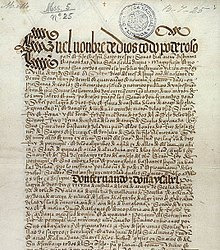
The House of Aviz has produced numerous prominent figures in both European and global history, including Prince Henrique the Navigator, King Manuel I of Portugal, and Holy Roman Empress Isabel of Portugal. Numerous Aviz dynasty have also claimed thrones or titles across Europe, including King Pedro V of Aragon
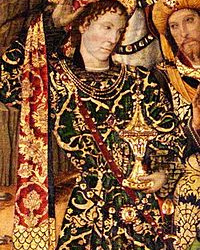
and João, Prince of Antioch.
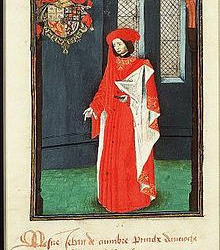
The Aviz ruled Portugal from 1385 until 1580.
The founder of the House of Aviz, King João I of Portugal, was born in 1357 as the illegitimate child of King Pedro I of Portugal, a member of the Portuguese House of Burgundy, and Teresa Lourenço, daughter of a Lisbon merchant. In 1364, at 7 years old, João was made Grand Master of the Order of Aviz,
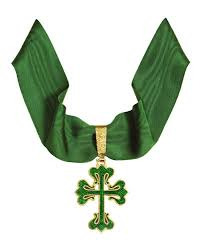
henceforth becoming known as João of Aviz.
The House of Aviz was established as a result of the dynastic crisis following the 1383 death of Fernando I. Fernando’s widow Leonor Telles was disliked by both the nobility and the commoners for having left her first husband and for having had their marriage annulled in order to marry King Fernando. Fernando’s designated heir was their only surviving child Beatriz,
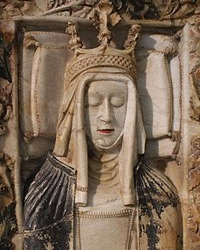
married to Juan I of Castile

who claimed the throne in the name of his wife, but under the Treaty of Salvaterra de Magos that had been the basis for Juan's marriage to Beatriz, the unpopular Leonor was left as Regent until such time as the son of Beatriz and Juan would be 14 years old.
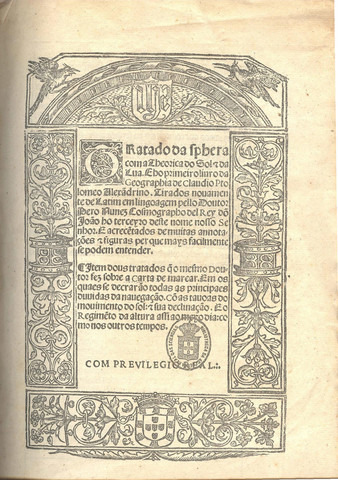
In April 1385, amidst popular revolt and civil war, the Cortes of Coimbra declared João, Master of Aviz, as king João I of Portugal. He was half-brother of Fernando and natural son of Fernando’s father and predecessor Pedro I. He had the particular backing of the rising bourgeoisie of Lisbon; the nobility were split, with the majority favoring the legitimist Beatriz. Troops under General Nuno Álvares Pereira

defeated a small Castilian army at Atoleiros,

while Juan of Castile had to lift a siege to Lisboa, mainly due to a plague that hit his army and killed his wife Beatriz. This was followed, however, by a larger invasion of Castilian and Portuguese troops loyal to Juan of Castile.
João of Aviz's rule became established fact with the Portuguese victory in the Battle of Aljubarrota on 14 August 1385, where he defeated Juan I of Castile.
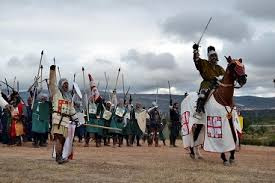
A formal peace between Portugal and Castile would not be signed until 1411.
To mark his victory, João founded the Monastery of Santa Maria da Vitória, known as the "Batalha Monastery",
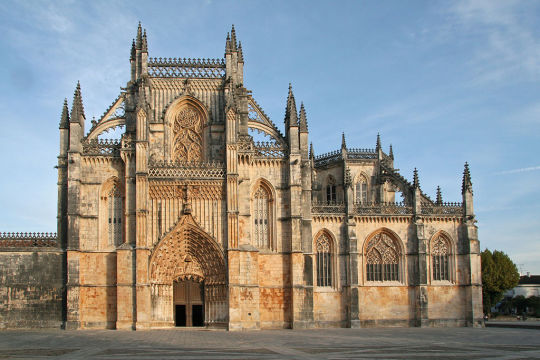
whose chapel became the burial place of the princes of the new dynasty of Aviz.
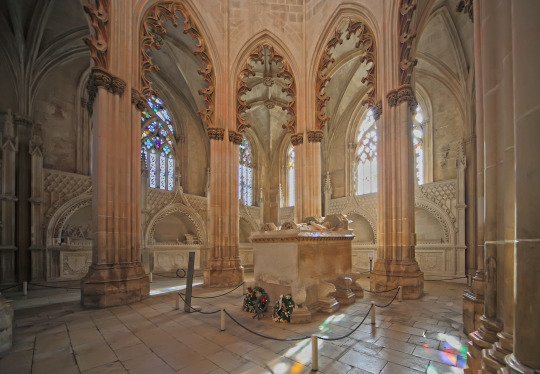
The descendants of King João I were still also Masters of Aviz, though at times that title passed to one descendant of João and the Crown of Portugal to another. The title of Grand Master of the Order of Aviz was permanently incorporated into the Portuguese Crown toward the end of rule by the House of Aviz, in 1551.
The House of Aviz would rule Portugal until its fall in the 1580 to the Philippine Dynasty.
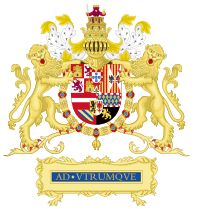
after he had ordered the Duke of Alba to take Portugal by force.
This period of Portuguese history saw the ascent of Portugal to the status of a European and world power. The conquest of Ceuta in 1415
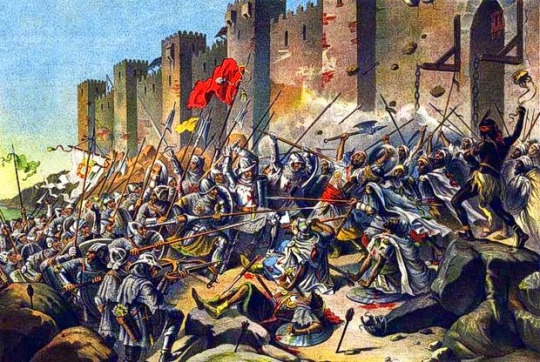
was its first venture in colonial expansion, followed by a great outpouring of national energy and capital investment in the exploration of Africa, Asia and Brazil with the founding of colonies to exploit their resources commercially. The period also includes the zenith of the Portuguese Empire during the reign of Manuel I and the beginning of its decline during João III's reign.
João III was succeeded in 1557 by his grandson Sebastião I of Portugal, who died, aged 24 and childless, in the Battle of Alcácer Quibir.

Sebastião was succeeded by his great-uncle Henrique, aged 66, who, as a Catholic Cardinal, also had no children. The Cardinal-King Henrique died two years later, and a succession crisis occurred when pretenders to the throne including Catarina, Duchess of Braganza,

Philip II of Spain,

and António, Prior of Crato claimed the right to inherit it.
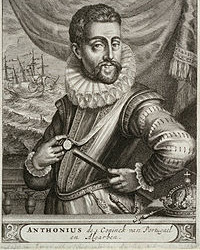
António, Prior of Crato, was acclaimed king in several cities around the country in 1580, twenty days before Philip II of Spain invaded Portugal and defeated the supporters of António in the Battle of Alcântara.

Although António had been proclaimed king, and was still regarded as rightful king in some of the Azores Islands until 1583, his legitimacy as a monarch is still disputed by historians. Only a small minority of historians (even in Portugal) accept the period of twenty days between Antonio's acclamation and the Battle of Alcântara as his reign. In Portugal he generally considered not as a national king, but as a patriot who led armed resistance to the Philippine domination.
Joaquim Veríssimo Serrão, writing in 1956 and counting António as a king, dates the end of the dynasty's rule of Portugal as occurring in 1581–1582. The Cortes of Tomar had acclaimed Philip II of Spain as Philip I of Portugal in 1581, subsequently António's forces were utterly defeated at sea by Álvaro de Bazán at the Battle of Ponta Delgada

off São Miguel Island in the Azores, on 26 July 1582. António then retreated to Terceira, where he supervised the raising of levies for defense, but in November he left Angra do Heroísmo en route to France to persuade the French to furnish more troops, 800 of which arrived in June 1583. Philip had dispatched Santa Cruz with an overwhelming force which left Lisbon on 23 June, and reaching sight of São Miguel some time after 7 July, finally reduced the Azores to subjection.
The Cortes in Tomar acknowledged Philip II of Spain as King Philip I of Portugal on 16 April 1581 after this Spanish military intervention. From 1581, the House of Aviz had ceased to rule any portion of continental Portugal; António, Prior of Crato held out in the Azores into 1582 as António I of Portugal; the last of his allies in the islands finally surrendered in 1583.
The House of Aviz was succeeded in Portugal by Philip's personal union of the Crowns of Portugal and Spain. In Portuguese history this is variously referred to as the Philippine Dynasty, the House of Habsburg, or the House of Austria. Portugal and Spain would share a common monarch until 1640, upon the proclamation of the Duke of Braganza as John IV of Portugal.
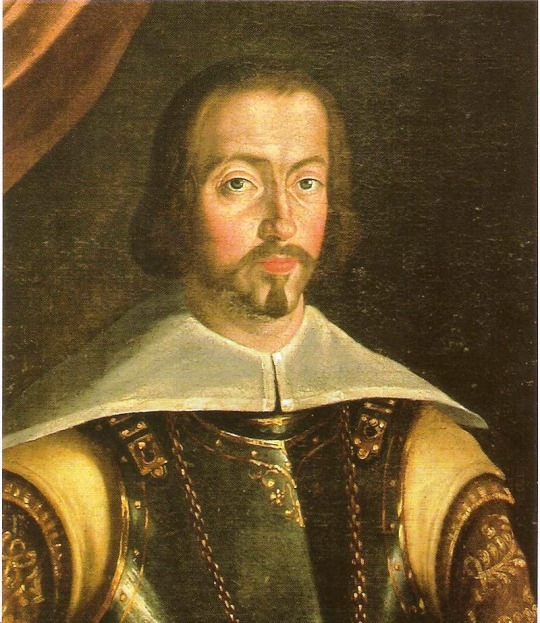
Aviz monarchs
João I of Portugal (1385–1433) Founder of the House of Aviz and the King with the longest reign of all the Kings of Portugal with 48 years.
Duarte I of Portugal (1433–1438) Oldest member of the Illustrious Generation
Afonso V of Portugal (1438–1481)
João II of Portugal (1481–1495)
Manuel I of Portugal (1495–1521) Formerly Duke of Beja
João III of Portugal (1521–1557)
Sebastião I of Portugal (1557–1578) Death at Battle of Alcácer Quibir triggers Portuguese succession crisis of 1580
Henrique I of Portugal (1578–1580) Last Aviz monarch recognized by the Portuguese Cortes
Symbols

Following his success in succeeding to the throne following the 1383–1385 Portuguese interregnum, King João I of Portugal took the Cross of the Order of Aviz as his heraldic badge, adding it to the coat of arms of Portugal and the according royal flags. King João I enforced the imagery of his position as Grand-Master of the Order of Aviz, lending its name to his newly founded royal house and its cross as his personal charge on the royal arms. This was effected in various ways: by insertion within the bordure, alternating with the castles; more commonly inserted within the shield, and occasionally shown outside the shield with the latter laying over it. The Cross of Aviz is a cross flory vert (a green cross with a fleur-de-lys at the end of each arm).

The armillary sphere has been an important element of Portuguese heraldry since the reign of King Manuel I of Portugal. The armillary sphere became a royal badge for the Portuguese monarchy, apart from being part of the personal standard of King Manuel I. It acts as a supporter to the Coat of arms of Portugal, also present on the current Flag of Portugal.

Owing to the association with King Manuel I and other Aviz monarchs with the Portuguese discoveries, the armillary sphere was commonly used as a symbol representing Portuguese sovereignty across the Portuguese Empire. The symbol was a consistent motif in both Manueline and Neo-Manueline architecture.


It also became particularly associated with Colonial Brazil and the subsequent United Kingdom of Portugal, Brazil, and the Algarves.
An important element of Portuguese heraldry since the 15th century, the armillary sphere was many times used in Portuguese naval and colonial flags, mainly in Brazil. It was a navigation instrument used to calculate distances and represents the importance of Portugal during the Age of Discovery,

as well as the vastness of its colonial empire when the First Republic was implemented.
Coats of arms
King of Portugal - 1385–1580

King of the Algarves - 1385–1580

7 notes
·
View notes
Photo

Gospel Reading and Commentary for December 9th - Second Sunday of Advent - Roman Catholic - Luke: 3: 1 - 6
1. Now in the fifteenth year of the reign of Tiberius Caesar, Pontius Pilate being governor of Judea, and Herod being tetrarch of Galilee, and his brother Philip tetrarch of Ituraea and of the region of Trachonitis, and Lysanias the tetrarch of Abilene,
2. Annas and Caiaphas being the High Priests, the word of God came to John the son of Zacharias in the wilderness.
GREG. The time at which the forerunner of the Savior received the word of preaching, is marked by the names of the Roman sovereign and of the princes of Judea, as it follows: Now in the fifteenth year of the reign of Tiberius Cesar, Pontius Pilate being governor of Judea, and Herod being tetrarch of Galilee, &c. For because John came to preach Him who was to redeem some from among the Jews, and many among the Gentiles, therefore the time of his preaching is marked out by making mention of the king of the Gentiles and the rulers of the Jews. But because all nations were to be gathered together in one, one man is described as ruling over the Roman state, as it is said, The reign of Tiberius Caesar.
GREEK EX. For the emperor Augustus being dead, from whom the Roman sovereigns obtained the name of “Augustus,” Tiberius being his successor in the monarchy, was now in the 15th year of his receiving the reins of government.
ORIGEN; In the word of prophecy, spoken to the Jews alone, the Jewish kingdom only is mentioned, as, The vision of Esaias, in the days of Uzziah, Jotham, Ahaz, and Hezekiah, kings of Judah. But in the Gospel which was to be proclaimed to the whole world, the empire of Tiberius Caesar is mentioned, who seemed the lord of the whole world. But if the Gentiles only were to be saved, it were sufficient to make mention only of Tiberius, but because the Jews s also must believe, the Jewish kingdom therefore, or Tetrarchies, are also introduced, as it follows, Pontius Pilate being governor of Judea, and Herod tetrarch, &c. GREG. Because the Jews were to be scattered for their crime of treachery, the Jewish kingdom was shut up into parts under several governors According to that saying, Every kingdom divided against itself is brought to desolation.
BEDE; Pilate was sent in the twelfth year of Tiberius to take the government of the Jewish nation, and remained there for ten successive years, almost until the death of Tiberius. But Herod, and Philip, and Lysanias, were the sons of that Herod in whose reign our Lord was born. Between these and Herod himself Archelaus their brother reigned ten years. He was accused by the Jews before Augustus, and perished in exile at Vienne. But in order to reduce the Jewish kingdom to greater weakness, Augustus divided it into Tetrarchies.
GREG. Because John preached Him who was to be at the same time both King and Priest, Luke the Evangelist has marked the time of that preaching by the mention not only of Kings, but also of Priests. As it follows, Under the High Priests Annas and Caiaphas. BEDE; Both Annas and Caiaphas, when John began his preaching, were the High Priests, but Annas held the office that year, Caiaphas the same year in which our Lord suffered on the cross. Three others had held the office in the intervening time, but these two, as having particular reference to our Lord’s Passion, are mentioned by the Evangelist. For at that time of violence and intrigue, the commands of the Law being no longer in force, the honor of the High Priest’s office was never given to merit or high birth, but the whole affairs of the Priesthood were managed by the Roman power. For Josephus relates, that Valerius Gratus, when Annas was thrust out of the Priesthood, appointed Ismael High Priest, the son of Baphas; but not long after casting him off, he put in his place Eleazar the son of the High Priest Ananias. After the space of one year, he expelled him also from the office, and delivered the government of the High Priesthood to a certain Simon, son of Caiaphas, who holding it not longer than a year, had Joseph, whose name also was Caiaphas, for his successor; so that the whole time during which our Lord is related to have taught is included in the space of four years.
AMBROSE; The Son of God being about to gather together the Church, commences His work in His servant. And so it is well said, The word, of the Lord came to John, that the Church should begin not from man, but from the Word. But Luke, in order to declare that John was a prophet, rightly used these few words, The word of the Lord came to him. He adds nothing else, for they need not their own judgment who are filled with the Word of God. By saying this one thing, he has therefore declared all. But Matthew and Mark desired to show him to be a prophet, by his raiment, his girdle, and his food.
CHRYS. The word of God here mentioned was a commandment, for the son of Zacharias came not of himself, but God moved him.
THEOPHYL. Through the whole of the time until his showing himself he was hid in the wilderness, that no suspicion might arise in men’s minds, that from his relation to Christ, and from his intercourse with Him from a child, he would testify such things of Him; and hence he said, He knew him not.
GREG NYSS. Who also entered this life at once in the spirit and power of Elias, removed from the society of men, in uninterrupted contemplation of invisible things, that he might not, by becoming accustomed to the false notions forced upon us by our senses, fall into mistakes and errors in the discernment of good men. And to such a height of divine grace was he raised, that more favor was bestowed upon him than the Prophets, for from the beginning even to the end, he ever presented his heart before God pure and free from every natural passion.
AMBROSE; Again, the wilderness is the Church itself, for the barren has more children than she who has an husband. The word of the Lord came, that the earth which was before barren might bring forth fruit unto us.
3. And he came into all the country about Jordan, preaching the baptism of repentance for the remission of sins;
4. As it is written in the book of the words of Esaias the prophet, saying, The voice of one crying in the wilderness, Prepare you the way of the Lord, make his paths straight.
5. Every valley shall be filled, and every mountain and hill shall be brought low; and the crooked shall be made straight, and the rough ways shall be made smooth;
6. And all flesh shall see the salvation of God.
AMBROSE; The Word came, and the voice followed. For the Word first works inward, then follows the office of the voice, as it is said, And he went into all the country about Jordan.
ORIGEN; Jordan is the same as descending, for there descends from God a river of healing water. But what parts would John be traversing but the country lying about Jordan, that the penitent sinner might soon arrive at the flowing stream, humbling himself to receive the baptism of repentance. For it is added, preaching the baptism of repentance for the remission of sins. GREG. It is plain to every reader that John not only preached the baptism of repentance, but to some also he gave it, yet his own baptism he could not give for the remission of sins. CHRYS. For as the sacrifice had not yet been offered up, nor had the holy Spirit descended, how could remission of sins be given? What is it then that St. Luke means by the words, for the remission of sins, seeing the Jews were ignorant, and knew not the weight of their sins? Because this was the cause of their evils, in order that they might be convinced of their sins and seek a Redeemer, John came exhorting them to repentance, that being thereby made better and sorrowful for their sins, they might be ready to receive pardon. Rightly then after saying, that he came preaching the baptism of repentance, he adds, for the remission of sins. As if he should say, The reason by which he persuaded them to repent was, as, that thereby they would the more easily obtain despair. For the hill produces no fruit. ORIGEN; Or you may understand the mountains and hills to be the hostile powers, which have been overthrown by the coming of Christ. BASIL; But as the hills differ from mountains in respect of height, in other things are the same, so also the adverse powers agree indeed in purpose, but are distinguished from one another in the enormity of their offenses. GREG. Or, the valley when filled increases, but the mountains and hills when brought low decrease, because the Gentiles by faith in Christ receive fullness of grace, but the Jews by their sin of treachery have lost that wherein they boasted. For the humble receive a gift because the hearts of the proud they keep afar off. CHRYS. Or by these words he declares the difficulties of the law to be turned into the easiness of faith; as if he said, No more toils and labors await us, but grace and remission of sins make an easy way to salvation. GREG NYSS. Or, He orders the valleys to be filled, the mountains and hills to be cast down, to show that the rule of virtue neither fails from want of good, nor transgresses from excess. GREG. But the crooked places are become straight, when the hearts of the wicked, perverted by a course of injustice, are directed to the rule of justice. But the rough ways are changed to smooth, when fierce and savage dispositions by the influence of Divine grace return to gentleness and meekness. CHRYS. He then adds the cause of these things, saying, And all flesh shall see, &c. showing that the virtue and knowledge of the Gospel shall be extended even to the end of the world, turning mankind from savage manners and perverse wills to meekness and gentleness. Not only Jewish converts but all mankind shall see the salvation of God. CYRIL; That is, of the Father, who sent His Son as our Savior. But the flesh is here taken for the whole man. GREG. Or else, All flesh, i.e. Every man can not see the salvation of God in Christ in this life. The Prophet therefore stretches his eye beyond to the last day of judgment, when all men both the elect and the reprobate shall equally see Him.
3 notes
·
View notes
Video
youtube
Saint of the Day – 23 April – St George (died c 303) also known as St George of Lydda, Jirí, Jordi, Zorzo, Victory Bringer – Martyr and Soldier. St George was born c 256-285 in Palestine and was tortured and beheaded to death in c 303 in Nicomedia, Bithynia, Roman Empire. Patronages – • against herpes • against leprosy • against plague • against skin diseases • against skin rashes • against syphilis • agricultural workers • Aragon • archers • armourers • Boy Scouts • butchers • Canada • Cappadocia • Catalonia • cavalry • chivalry • Crusaders • England • equestrians • Ethiopia • farmers • field hands • field workers • Georgia • Germany • Greece • halberdiers • horsemen • horses • husbandmen • knights • lepers • Lithuania • Malta • Montenegro • Order of the Garter • Palestine • Palestinian Christians • Portugal • riders • Romanian Army • saddle makers • saddlers • Serbia • sheep • shepherds • soldiers • Teutonic Knights • 2 dioceses • 181 cities.

St George was a Roman soldier of Greek origin and officer in the Guard of Roman emperor Diocletian, who was sentenced to death for refusing to recant his Christian faith. As a Christian martyr, he later became one of the most venerated saints in Christianity and was especially venerated by the Crusaders. George’s parents were Christians of Greek background, his father Gerontius was a Roman army official from Cappadocia and his mother Polychronia was a Christian and a Greek native from Lydda in the Roman province of Syria Palaestina.
St George is commemorated and remembered as one of the Fourteen Holy Helpers and one of the most prominent military saints, he is immortalised in the myth of Saint George and the Dragon. Due to his chivalrous behaviour (protecting women, fighting evil, dependence on faith and might of arms, largesse to the poor), devotion to Saint George became popular in the Europe after the 10th century. In the 15th century his feast day was as popular and important as Christmas. Many of his areas of patronage have to do with life as a knight on horseback. The celebrated Knights of the Garter are actually Knights of the Order of Saint George. The shrine built for his relics at Lydda, Palestine was a popular point of pilgrimage for centuries.

There is little information on the early life of Saint George. Herbert Thurston in The Catholic Encyclopedia states that based upon an ancient cultus, narratives of the early pilgrims and the early dedications of churches to Saint George, going back to the fourth century, “there seems, therefore, no ground for doubting the historical existence of St. George”. According to Donald Attwater, “No historical particulars of his life have survived, … The widespread veneration for St George as a soldier saint from early times had its centre in Palestine at Diospolis, now Lydda. St George was apparently martyred there, at the end of the third or the beginning of the fourth century; that is all that can be reasonably surmised about him.”
On 24 February 303, Diocletian, who hated Christians, announced that every Christian the army passed would be arrested and every other soldier should offer a sacrifice to the Roman gods. George refused to abide by the order and told Diocletian, who was angry but greatly valued his friendship with George’s father. When George announced his beliefs before his peers, Diocletian was unable to keep the news to himself. In an effort to save George, Diocletian attempted to convert him to believe in the Roman gods, offered him land, money and slaves in exchange for offering a sacrifice to the Roman gods and made several other offers that George refused.
Finally, after exhausting all other options, Diocletian ordered George’s execution. In preparation for his death, George gave his money to the poor and was sent for several torture sessions. He was lacerated on a wheel of swords and required resuscitation three times but still George did not turn from God.

George was decapitated before Nicomedia’s outer wall. His body was sent to Lydda for burial and other Christians went to honour George as a martyr.
Saint George and the Dragon
There are several stories about George fighting dragons but in the Western version, a dragon or crocodile made its nest at a spring that provided water to Silene, believed to be modern-day Lcyrene in Libya. The people were unable to collect water and so attempted to remove the dragon from its nest on several occasions. It would temporarily leave its nest when they offered it a sheep each day, until the sheep disappeared and the people were distraught. This was when they decided that a maiden would be just as effective as sending a sheep. The townspeople chose the victim by drawing straws. This continued until one day the princess’ straw was drawn. The monarch begged for her to be spared but the people would not have it. She was offered to the dragon but before she could be devoured, George appeared. He faced the dragon, protected himself with the sign of the Cross and slayed the dragon. After saving the town, the citizens abandoned their paganism and were all converted to Christianity.

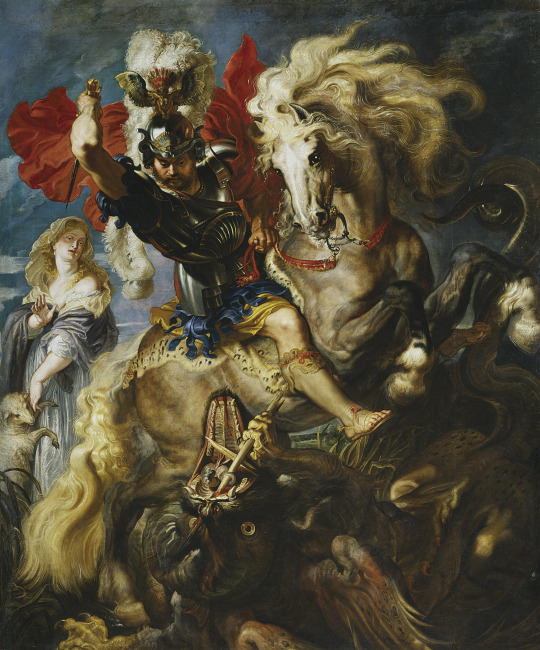

Interesting Facts
Saint George stands out among other saints and legends because he is known and revered by both Muslims and Christians.
It is said Saint George killed the dragon near the sea in Beirut, thus Saint George Bay was named in his honour.
Saint George’s feast day is celebrated on 23 April but if it falls before Easter, it is celebrated Easter Monday.
The Russian Orthodox Church celebrates three St George feast days each year -23 April, 3 November, to commemorate the consecration of a cathedral dedicated to him in Lydda, and on 26 November for when a church in Kiev was dedicated to him.
In Bulgaria, his feast day is celebrated 6 May with the slaughter and roasting of a lamb.
In Egypt, the Coptic Orthodox Church of Alexandria calls St George the “Prince of Martyrs” and celebrates on 1 May. There is a second celebration 17 November in honour of the first church dedicated to him.
Saint George is the patron saint of England and Catalonia and his cross can be found throughout England including on the English and other Commonwealth flags.
In older works, Saint George is depicted wearing armour and holding a lance or fighting a dragon, which represents Christ’s enemies.
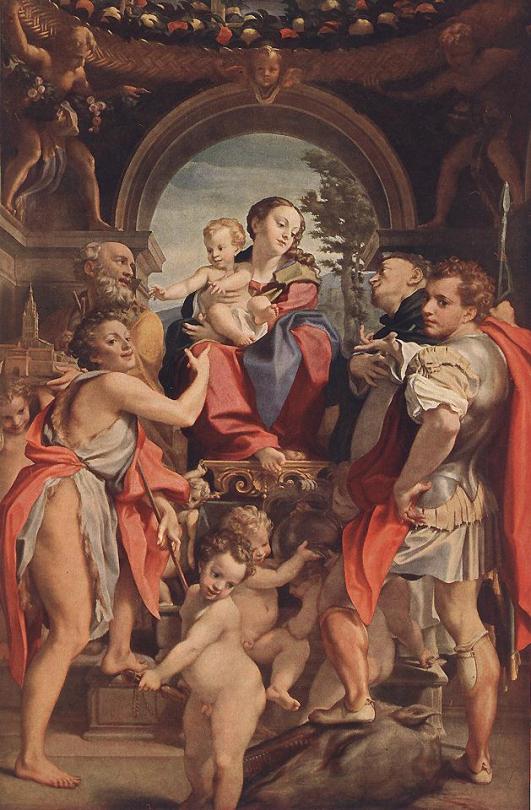
(via AnaStpaul – Breathing Catholic)
52 notes
·
View notes
Text

Posthumous portrait of Mary of Burgundy (1457 –1482) , wife of Archduke Maximilian of Austria, future Holy Roman Emperor, by Niklas Reiser, c. 1500
#1500s#16th century#Niklas Reiser#holy roman empire#16th c. holy roman empire#15th century#15th c. holy roman empire#late 15th century#mdp15th c.#mdp16th c.#austria#16th c. austria#15th c. austria#sovereign#burgundy#headdress
99 notes
·
View notes
Photo

In Game:
Jerusalem is a city located in the hills of the Judean Mountains, in between the Mediterranean Sea and the Dead Sea.
By the time of the Third Crusade, the city secretly housed both Templars and Assassins. In 1191, a group of Templars led by their Grand Master Robert de Sable and a team of Assassins composed of Altaïr Ibn-La'Ahad and the brothers Kadar and Malik Al-Sayf infiltrated Solomon's Temple in Jerusalem, to obtain an Apple of Eden, which was hidden deep inside the temple atop the Ark of the Covenant.
When both factions met, it resulted in a conflict that led to the death of Kadar and the severe wounding of Malik's arm, though Malik was successfully able to bring the Apple of Eden back to the headquarters of the Levantine Assassins in Masyaf.
Throughout the rest of the year, in order to redeem his failure due to his arrogance and disregard for the Assassins' Creed, Altaïr assassinated several clandestine Templars who worked inside Jerusalem. He did so with the help of Malik Al-Sayf, who had become the Rafiq of the city's Assassin bureau.
Among these Templars was Talal, a slave trader, and Majd Addin, the regent of Jerusalem in Saladin's absence.

Ultimately, Altaïr also attempted to take the life of Robert de Sable during Majd Addin's funeral; however, he failed due to Robert having taken precautions and disguising his fellow Templar Maria Thorpe as himself to act as a decoy.
When Altaïr, who by 1257 had become the Mentor of the Levantine Assassins, dispersed the Assassin Order from Masyaf, they shifted their primary presence in the Levant to Jerusalem, working in secret.
In Real Life:
Jerusalem is an ancient city located in ancient Judah that is now the capital of Israel. The city has a history that goes back to the 4th millennium BCE, making it one of the oldest cities in the world. It is the holiest city in Judaism and Christianity and has been the spiritual center of the Jewish people since c. 1000 BCE, when David the King of Israel first established it as the capital of the Jewish Nation, and his son Solomon commissioned the building of the First Temple in the city.
According to Hebrew scripture, King David reigned until 970 BCE. He was succeeded by his son Solomon, who built the Holy Temple on Mount Moriah. During the so-called First Temple Period, Jerusalem was the political capital of firstly the united Kingdom of Israel and then the Kingdom of Judah and the Temple was the religious center of the Israelites. The First Temple period ended around 586 BCE, as the Babylonian ruler Nebuchadnezzar II laid waste to Solomon's Temple and took a significant number of Jews captive in response to a revolt. In 538 BCE, after fifty years of Babylonian captivity, Persian King Cyrus the Great invited the Jews to return to Judah to rebuild the Temple. Construction of the Second Temple was completed in 516 BCE, during the reign of Darius the Great, seventy years after the destruction of the First Temple.
Until the 7th century CE the city repeatedly changed hands between the Roman Empire, the Byzantine Empire, and the Sassanid Empire. In 638 the Islamic Caliphate extended its dominion to Jerusalem, which is considered Islam's third holiest city after Mecca and Medina. With the Arab conquest, Jewish people were allowed back into the city. Until the Crusades Jerusalem remained under Arab control.
During the First Crusade, Jerusalem was under siege by the Crusaders from June 7th to July 15th, 1099. The successful siege saw the Crusaders take Jerusalem from the Fatimid Caliphate and laid the foundations for the Kingdom of Jerusalem.

.(Image source)
The city was retaken by the Muslims during the Second Crusade. During the Third Crusade, however, the Crusaders’ campaign was largely successful in capturing the important cities of Acre and Jaffa, and reversing most of Saladin's conquests, but it failed to capture Jerusalem, the emotional and spiritual motivation of the Crusade.
After the failure of the Second Crusade, the Zengid dynasty controlled a unified Syria and engaged in a conflict with the Fatimid rulers of Egypt. The Egyptian and Syrian forces were ultimately unified under Saladin, who employed them to reduce the Christian states and recapture Jerusalem in 1187. Spurred by religious zeal, King Henry II of England and King Philip II of France (known as Philip Augustus) ended their conflict with each other to lead a new crusade. The death of Henry in 1189, however, meant the English contingent came under the command of his successor, King Richard I of England (known as Richard the Lionheart). The elderly German Emperor Frederick Barbarossa also responded to the call to arms, leading a massive army across Anatolia, but he drowned in a river in Asia Minor on June 10th, 1190 before reaching the Holy Land. His death caused tremendous grief among the German Crusaders, and most of his troops returned home.
After the Crusaders had driven the Muslims from Acre, Philip in company with Frederick's successor, Leopold V, Duke of Austria (known as Leopold the Virtuous), left the Holy Land in August 1191. On September 2nd, 1192, Richard and Saladin finalized a treaty granting Muslim control over Jerusalem but allowing unarmed Christian pilgrims and merchants to visit the city. Richard departed the Holy Land on October 9th. The successes of the Third Crusade allowed the Crusaders to maintain considerable states in Cyprus and on the Syrian coast. However, the failure to recapture Jerusalem would lead to the Fourth Crusade.
Sources:
http://www.history.com/topics/crusades
https://en.wikipedia.org/wiki/Third_Crusade
https://www.ancient.eu/jerusalem/
http://www.lordsandladies.org/the-third-crusade.htm
https://en.wikipedia.org/wiki/Siege_of_Jerusalem_(1099)
15 notes
·
View notes
Text
EVERY QUIVER OF HIS BEATING HEART .....
__________________________________________________
Am I the current king of England ... or are we here to see the queen?
Just like Mycroft is strongly connected with the term 'QUEEN', Sherlock is more than once connected to the 'KING'. In a way, both ot them represent 'ENGLAND/LONDON' with Mycroft as the Government, Sherlock as the countly, the city, the body ... and Baker Street 221b as the metaphorical heart of it. The voice given to that heart seems to be Mrs. Hudson but also John.
Mrs Hudson leave Baker Street? England would fall.
Once in a while Mycroft, in his function as government (brain), turns up - spying, controlling, offering dubious cases. Then John Watson moves in and 'takes the room upstairs'. John just came back from the East - from the battlefields of Afghanistan - scarred and badly wounded. Walking at the side of Sherlock Holmes, he sets his feet now onto a different kind of 'battlefield' ... as the brain tells him.
Most people blunder round this city, and all they see are streets and shops and cars. When you walk with Sherlock Holmes, you see the battlefield. You’ve seen it already, haven’t you?
On another day in the story Sherlock comes back from the East as well - from imprisonment and torture in Serbia - scarred and wounded himself. Most urgently summoned by his brain (Mycroft) because 'there's going to be a terror strike on London - a big one'. (terrorists=emotions)
Just put me back in London. I need to get to know the place again, breathe it in – feel every quiver of its beating heart.

Sherlock clearly enjoys HIS big city ... London. Seems he is indeed a 'city boy' just like his mirror Edward Van Coon in TBB. It doesn't seem likely that Sherlock could bear to live somewhere else for a longer period of time.
London. It’s like a great cesspool into which all kinds of criminals, agents and drifters are irresistibly drained.

And it looks like John Watson has very similar feelings where London is concerned ...
I returned to England with my health irretrievably ruined and my future bleak. Under such circumstances, I naturally gravitated to London, that great cesspool into which all the loungers and idlers of the Empire are drained.
But of course, this is from TAB and therefore in Sherlock's own head. What goes on in his head though? Is he considering how John might have felt upon returning from the war in Afghanistan .... or is he reliving his own return from his own 'war' back in TEH?
And then - when Sherlock, John and Mycroft encounter the 'final problem' - all three of them decide to be soldiers that day. Even Mycroft .....
JOHN: Today we have to be soldiers, Mycroft, soldiers ...
SHERLOCK: Soldiers today.
SHERLOCK: Soldiers?
JOHN: Soldiers.
MYCROFT: Today, we are soldiers.
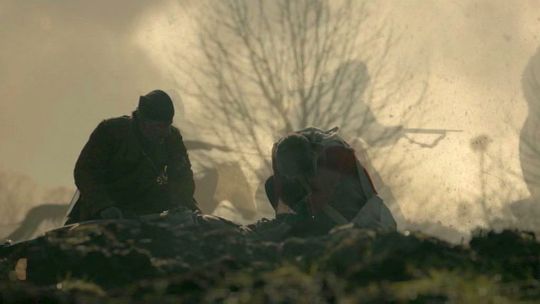
Playing once more with a methaphorical reading of Sherlock BBC where England/London represents Sherlock's body. It's part of a thread I decided to call 'Sherlock deducing Sherlock'. And of course, this is just one of several threads running through this story ... side by side .... every single one telling a different story.
More under the cut ... mostly vexillology and history but also lions and dragons .... beware ..... :))))
England/London ... the body ... Sherlock
The government ... the brain ... Mycroft
221b Baker Street ... the heart ... John
How the flag of England came into being ... the Union Jack
The flag combines aspects of three older national flags. The first version dates back to 1606 when James VI of Scotland united the crowns of Engalnd, Scotland and Ireland in a personal union, although the three kingdoms remained separate states. (X)

the white saltire on blue background of St Andrew to represent Scotland
the red saltire on white background of St Patrick to represent Ireland
the red cross on white background of St George for the Kingdom of England,

Saint George's cross
Its first documented use was as the ensign of the Republic of Genoa. Later it was used by cursaders. The cross ceased to be a symbol directly associated with the "taking of the cross", the resolve to fight in a crusade, after the failure of the crusades in the 14th century.
The St. George's flag, was adopted by England and the City of London in 1190 for their ships entering the Mediterranean to benefit from the protection of the Genoese fleet.
From 1348 and throughout the 15th century, the Saint George's Cross was shown in the hoist of the Royal Standards of the Plantagenet kings of England. The combined flag form 1606 was initially for maritime display, later restricted to the King's ships.
The symbol has since been adopted as the emblem of several countries and cities which have or had Saint George as a patron saint, notably the Republic of Genoa, the Duchy of Milan, England, Wales and Georgia in the Caucasus Mountains of Eastern Europe. (X)
Georgia and Tiblisi
Regarding Sherlock BBC several important things happen in this country. In fact, Georgia is (though just for some short scenes) more heavily featured than any other country in this story appart from Great Britain itself.
That's Tiblisi. Isn't it beautiful?

The legendary Black Pearl of the Borgias is stolen from a secret vault
The ambassador and her husband are taken hostage and killed
AGRA - the group of 'super-agents' - sent in to free the hostages - are deceived and get destroyed
One ot the important memory sticks is hidden in a Thatcher plaster bust manufactured in a workshop inside (?) or at least very close to the ambassy
A batch of those busts - including exactly the one with the hidden memory stick - is supplied to London.
The creators of Sherlock BBC could have chosen any country in the world for any of the events mentioned above. Why did they go for Georgia? Well, maybe .....
... the name, the flag, the coat of arms?
The flag of Georgia is also known as the Five Cross Flag. Originally a banner of the medieval Kingdom of Georgia, it was brought back during periods of Georgias national revival and served as one of the most recognizable symbols of the bloodless Rose Revolution. Since 2004 it is the official flag of Georgia.

This Five Cross Flag of Georgia is a red-on-white version of the Jerusalem Cross. The four small crosses are officially described as 'Bolnisi Crosses', even though they are only slightly 'pattée' .... meaning that the arms are narrow at the center, often flared in a curve or straight line shape, to be broader at the perimeter ... like the Maltese cross.
The coat of arms of the Kingdom of Jerusalem were originally displayed in gold on silver. But the colors could be changed. Usually metal on metal, brakes the heraldic Rule of Tincture. It was justified in this case by the fact that Jerusalem was so holy, it was above ordinary rules.
The five-fold cross symbolizes either the Five Wounds of Christ, Christ and the four evangelists or Christ and the four quarters of the world.
If England represents Sherlock's body, the red cross of Saint George and the name of the saint himself connect Sherlock very closely to Georgia. And the Five Cross Flag of Georgia constitutes a connection to Jerusalem and Christ. Another Christ reference in this story it seems ....

Georgia's coat of arms features an image of Saint George, riding a horse trampling upon a dragon, whose head is pierced by the saint's spear. Two lions are supporting the shield, which is surmounted with the royal crown of Georgia. The motto below the shield reads "Strength is in Unity"
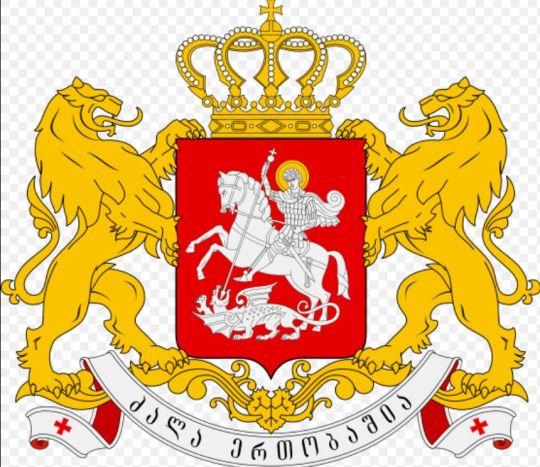
Saint George's monument in front of the City Council in Tiblisi, Georgia

The Tiblisi incident
When AGRA are storming the embassy in Tiblisi the 'Five Cross Flag' can be seen very prominently in the background .... it looks like it has been blown into the open window by a draft of air .... but the weather must have changed ... because despite the still open window and all the action in the room, neither flag nor curtains are moving one bit throughout the whole scene.

Two life-size statues of lions are dramatically flanking the centre of the room ......

Saint George and the dragon
According to legend, Saint George was a roman soldier of greek origin and officer in the guard of Roman empereor Diocletian. He is one of the most prominent military saints and immortalised in the myth of Saint George and the Dragon. While the veneration of Saint George as a soldier saint goes back to the 7th century at least, the earliest known surviving narrative of the dragon episode is an 11th-century Georgian text.
The town had a small lake with a plague-bearing dragon living in it and poisoning the countryside. To appease the dragon, the people fed it two sheep every day. When they ran out of sheep they started feeding it their children, chosen by lottery. One time the lot fell on the king's daughter. The king, in his grief, told the people they could have all his gold and silver and half of his kingdom if his daughter were spared; the people refused. The daughter was sent out to the lake, dressed as a bride, to be fed to the dragon.
Saint George by chance rode past the lake. The princess tried to send him away, but he vowed to remain. The dragon emerged from the lake while they were conversing. Saint George charged it on horseback, seriously wounding it with his lance. He then called to the princess to throw him her girdle, and he put it around the dragon's neck. When she did so, the dragon followed the girl like a meek beast on a leash.
Of course, the story ends like almost any dragon story does .... despite 'meek and on a leash' the dragon has to die.
A dragon living in water, a game of chance, a damsel in dirstress dressed as bride, a knight making a vow, a dragon on a leash .... well, well .... if this doesn't sound familiar .....

The work of an unknown artist: Saint George and the dragon from De Grey Hours (a medieval Book of Hours probably written for the De Grey family of Ruthin c.1390) National Library of Wales
Once more unto the breach, dear friends ....
"Once more unto the breach, dear friends ... once more!
Or close the wall up ... with our English dead!
... set the teeth and stretch the nostril wide.
Hold hard the breath and bend up every spirit ... to his full height!
On, on, you noblest English ... whose blood is fet from fathers of war-proof!
And you, good yeoman, whose limbs were made in England, show us here the mettle of your pasture!
... which I doubt not, for there is none of you so mean and base ... that hath not noble lustre in your eyes!
I see you stand like greyhounds in the slips, straining upon the start!
The game’s afoot.”
In The Lying Detective Sherlock quotes William Shakespeare's HENRY V, Act 3, Scene1. Among other parts, the last two lines of the monologue are missing:
Follow your spirit: and upon this charge, cry ....
God for Harry! England and Saint George!
Saint George is the patron saint of England and the protector of the royal family. His cross forms the national flag, and features within the Union Flag of the United Kingdom.
Again - if England indeed represents Sherlock's body, the red cross of Saint George and the saint himself connect Sherlock very closely to Georgia, Tiblisi ... AND the hostage incident in the embassy as well.
Is this maybe a supressed and coded memory? Georgia representing England at some time in the past .... in Sherlock's past? Is 'Georgia' not a different country but a different time? Dead people in Sherlock's past? Did he triy/wish to save them, but failed? Because he was just a child at that time? And was there really some foul play involved? Has Sherlock told himself another different/better story, to 'get rid' of the painful memory of the actual event?
But this isn't the end of this post yet .... there are still more connections ....
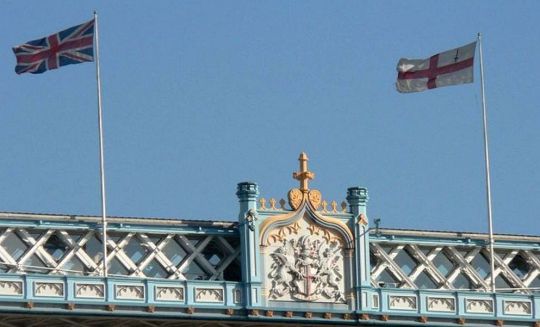
The Royal Arms of England
It was first adopted in a fixed form round 1200 by the Plantagenet kings and depicts three identical gold lions with blue tongues and claws, walking past but facing the observer, arranged in a column on a red background.
This design has not been altered since then. Over the centuries it has been variously combined with the signs and symbols of other kings and royal houses, according to dynastic and political changes occuring in England.
The present coat of arms of the United Kingdom used by Queen Elizabeth II includes a harp for Ireland and for Scotland a rampant lion surrounded by a flowered border. The dexter supporter is a crowned English lion; the sinister supporter, a Scottish unicorn. The Motto 'Dieu et mon droit' translates to 'God and my right' (X X)
(dexter & sinister = right or left from the POV of the bearer of the shield)
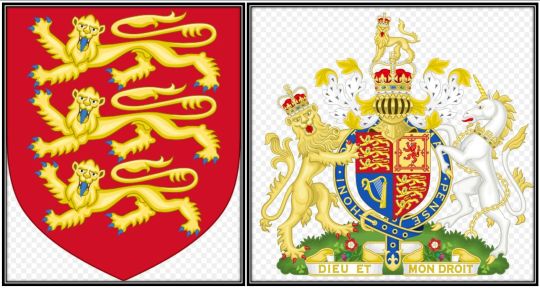
During the promotion for S4 the Union Jack and the crowned English lion made their appearance together with a mysterious question mark .... and the term 'sinister' showed up two times as well in tweets.
Related posts: The mirrored question mark Question mark and eyes Lions Sinister & orphans Mark's 'sinister' tweets The sinister hand

The flag of the City of London
It is based on the flag of England but represets only the historical City of London .... not Greater London. The sword symbolises the sword that beheaded Saint Paul who is the patron saint of the city. (X)
(A sword is definitely no blunt instrument but a sharp weapon which can also be 'wielded with precision and without remorse' .... like a scalpel ... :))))
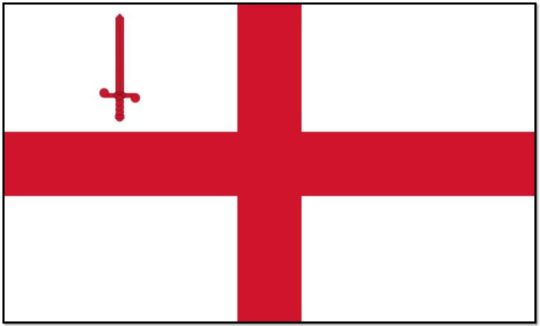
Coat of arms of the City of London
It consists of a silver shield bearing a red cross with a red upright sword in the first quarter, combining the emblems of the patron saints of England and London: the Cross of St George with the symbol of the martyrdom of Saint Paul.
Sherlock looking out over London ... Saint Paul's Cathedral to his right.

The crest depicts a dragon's left (sinister) wing bearing also the cross of St George, borne upon a peer's helmet. (X)
(A helmet is part of a knights armour, worn to shield the head. Broadly speaking, a helmet is rather similar to a mask ... hiding/covering head and face of a person. No one is able to recognize who's relly behind such an armour. Could be anyone. It's rather similar to ... 'putting on a facade'. Just saying .... :))))

Two silver dragons bearing red crosses upon their wings are supporting the arms. The latin motto of the City is Domine dirige nos, which translates to "Lord, direct (guide) us".
DIMMOCK: I go where you point me.
SHERLOCK (walking away): Exactly.
(Sorry, couldn't resist this bit of dialoge from The Blind Banker. It's just too good! And John's words from HLV 'Your way. Always your way' run exactly in the same vein as well. :))))
There be dragons .....
In the episode The Blind Banker (S1) the Yellow Dragon Circus comes to London to retrieve something that was stolen. Not the Black Pearl of the Borgias, no .... but something almost equally small and probably equally valuable ... a jade hairpin in the shape of a snake. Or is it a tiny Chinese baby dragon? Anyway, snake or dragon, both are reptiles. And the showdown of that episode takes place at a place called ... 'Dragon Den, Black Tramway'
And the dragon references continue .....
JIM: Sir Boast-a-lot was the bravest and cleverest knight at the Round Table, but soon the other knights began to grow tired of his stories about how brave he was and how many dragons he’d slain ...
MYCROFT: He (Magnusson) is a necessary evil – not a dragon for you to slay.
SHERLOCK: A dragon slayer. Is that what you think of me?
MYCROFT: No. It’s what you think of yourself.
MYCROFT: ... but on balance you have more utility closer to home.
SHERLOCK: Utility? How do I have utility?
MYCROFT: “Here be dragons.”
MARY: Sherlock the dragon slayer.
Dragon or dragon slayer ... that's the question
Or could it be both? Is Sherlock not only the dragon slayer but also the dragon?
"... in your case, solitary confinement is locking you up with your worst enemy"
Sherlock at war with himself? Sherlock fighting parts of himself? The dragon fighting his inner dragon? And even his brain tells him 'this is a war we MUST lose'. Could Sherlock really be that dragon himself?
Well, it is said that dragons are breathing fire .... wherever there is fire there is smoke as well ...... :))))))



All pics not Sherlock BBC are from Wikipedia and related to the sites I used for gathering information. Thanks @callie-ariane for the scripts.
I leave you to your own deductions.
November, 2017
@gosherlocked @loveismyrevolution @sagestreet @sherlockshadow @raggedyblue @monikakrasnorada @possiblyimbiassed @sarahthecoat @darlingtonsubstitution @devoursjohnlock @tjlcisthenewsexy @kateis-cakeis @tendergingergirl
91 notes
·
View notes
Text
281J Early 15th century Homiliary
{Homiliarius doctorum qui omiliarius dici solet … Hieronymi Augustini, Ambrosii, Jo. Chrysostomi, Gregorii, Origenis, Bede et complures ..}?
St Augustine (354- 430), John Christomos (349-407) St Benedict , Pope Leo I(440-61) ( and others)
For this collection of Homilies, who was the editor is not certain, and while traditionally it is attributed to Paul the Deacon approximately 720-799 There is also supposition that it was collected by Alcuin or even Bede.
What we do know is that the production of
Homiliary began in the 780s when Charlemagne (742/743–814) appointed Paul the Deacon to compose a Homiliary. Charlemagne,” has been represented as the sponsor or even creator of medieval education, and the Carolingian renaissance has been represented as the renewal of Western culture. This renaissance, however, built on earlier episcopal and monastic developments, and, although Charlemagne did help to ensure the survival of scholarly traditions in a relatively bleak and rude age, there was nothing like the general advance in education that occurred
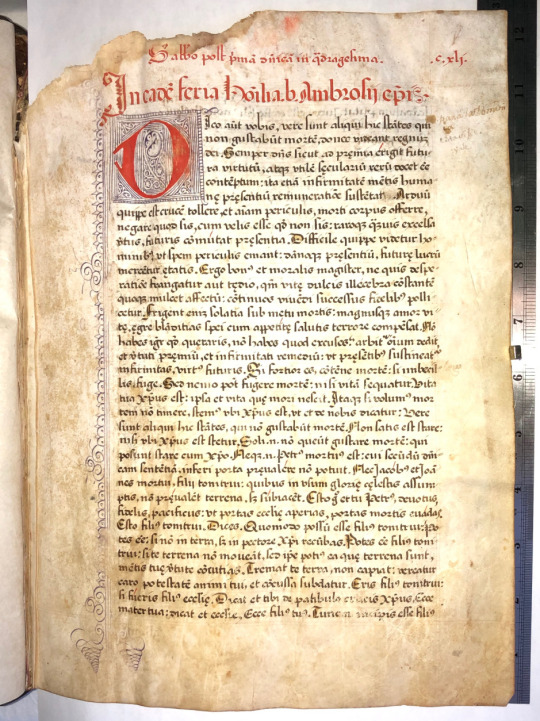
later with the cultural awakening of the 11th and 12th centuries. Learning, nonetheless, had no more ardent friend than Charlemagne, who came to the Frankish throne in 768 distressed to find extremely poor education systems” [EB] “Charlemagne stands out as the personification of everything that is unselfish and noble, a conqueror who visualized himself as the champion of European unity with the purpose of saving Europe through imperial conquest—an evangelist with a sword. As it turns out, Charlemagne did see himself as the Conqueror of everything pagan and heterodox and the divinely destined builder of Augustine’s City of God—of “one God, one emperor, one pope, one city of God.”[2] It was as if Charlemagne consciously sought to fulfill Plato’s vision of the ideal philosopher king. After all, Europe badly needed a conquering strong man like David of old, who could exercise wisdom and discernment in the sustainment of God’s new Jerusalem on earth.” [Gregory W. Hamilton ;http://nrla.com/charlemagne-and-the-vision-of-a-christian-empire/]N
So, We do know that ” From a very early time the Homilies of the Fathers were in high esteem, and were read in connection with the recitation of the Divine Office. That the custom was as old as the sixth century we know since St. Gregory the Great refers to it, and St. Benedict mentions it in his rule (Pierre Batiffol, History of the Roman Breviary, 107). This was particularly true of the homilies of Pope St. Leo I, very terse and peculiarly suited to liturgical purposesThis particular Homilarium Begins [folio cxli] with Ambrose (340-397) Homilies for the Quadragesima (forty days of Lent -Yes lent is longer than 40 days even though there are more 40 days from Ash Wednesday to Easter. ( counting the days of Lent excluding its Sundays and the Sacred Triduum, which technically is a separate sacred time.) This takes up to folio 224 (cclxxiiii). Following St Ambrose who has iv sermons in this section are sermons by Origen, Bede , John Chrystosom Cyrill , Augustine , Peter Chrysologus Archbishop of Ravenna , Alcuin of York .

After the Quadragesima series begins the Homilies for The Passion of Christ (Holy Week) On Palm Sunday, Jesus and his disciples spent the night in Bethany, a town about two miles east of Jerusalem. This is where Lazarus, whom Jesus had raised from the dead, and his two sisters, Mary and Martha lived. They were close friends of Jesus, and probably hosted Him and His disciples during their final days in Jerusalem.

This section (folios 141-245 )of Homilies begins at Quadragesima see above.
Then Holy Week/Passione homilies occupy folios 246-312.
Augustine of Hippo (13 November 354 – 28 August 430 AD) ,Gregory (3 September 590 to 12 March 604 AD) , Pope Leo (440-416 AD), Chrystomos (347–407)
Next in course is Palm Sunday “Dominica in ramis palmarum folios 313-337
Abbot Bernard (1090-1153), Pope Leo (440–461), Cyprian (200-258) , Chrystomos(347-407) Ambrose: (c339-397)
The final leaf is Easter Saturday (Sabbato sancto pasche)

Probably the first 140 leaves made up Homiletic commentaries on the Old Testament: the Hexaemeron (Six Days of Creation); De Helia et ieiunio (On Elijah and Fasting); De Iacob et vita beata (On Jacob and the Happy Life); De Abraham; De Cain et Abel; De Ioseph (Joseph); De Isaac vel anima (On Isaac, or The Soul); De Noe (Noah); De interpellatione Iob et David (On the Prayer of Job and David); De patriarchis (On the Patriarchs); De Tobia (Tobit); Explanatio psalmorum (Explanation of the Psalms); Explanatio symboli (Commentary on the Symbol).
Saint Augustine:

Peter Chrysologus:
(c. 380 – c. 450) Archbishop of Ravenna, approximately 400-450 , The earliest printed work by Chrysologus is 1575 Insigne et pervetvstvm opvs homiliarum.He is known as the “Doctor of Homilies” for the concise but theologically rich reflections he delivered during his time as the Bishop of Ravenna. His surviving works offer eloquent testimony to the Church’s traditional beliefs about Mary’s perpetual virginity, the penitential value of Lent, Christ’s Eucharistic presence, and the primacy of St. Peter and his successors in the Church. Few details of St. Peter Chrysologus’ biography are known. He was born in the Italian town of Imola in either the late fourth or early fifth century, but sources differ as to whether this occurred around 380 or as late as 406.
John Chrystosom

Beyond Chrstostoms preaching, the other lasting legacy of John is his influence on Christian liturgy. Two of his writings are particularly notable. He harmonized the liturgical life of the Church by revising the prayers and rubrics of the Divine Liturgy, or celebration of the Holy Eucharist. To this day, Eastern Orthodox and Eastern Catholic Churches of the Byzantine Rite typically celebrate the Divine Liturgy of Saint John Chrysostom as the normal Eucharistic liturgy, although his exact connection with it remains a matter of debate among experts.
Saint Cyrill.

Cyril’s jurisdiction over Jerusalem was expressly confirmed by the First Council of Constantinople (381), at which he was present. At that council he voted for acceptance of the term homoousios,(“consubstantial” this term was later also applied to the Holy Spirit in order to designate it as being “same in essence” with the Father and the Son. Those notions became cornerstones of theology in Nicene Christianity, and also represent one of the most important theological concepts within the Trinitarian doctrinal understanding of God) having been finally convinced that there was no better alternative. Cyril’s writings are filled with the loving and forgiving nature of God which was somewhat uncommon during his time period. Cyril fills his writings with great lines of the healing power of forgiveness and the Holy Spirit, like “The Spirit comes gently and makes himself known by his fragrance. He is not felt as a burden for God is light, very light. Rays of light and knowledge stream before him as the Spirit approaches. The Spirit comes with the tenderness of a true friend to save, to heal, to teach, to counsel, to strengthen and to console”. Cyril himself followed God’s message of forgiveness many times throughout his life. This is most clearly seen in his two major exiles where Cyril was disgraced and forced to leave his position and his people behind. He never wrote or showed any ill will towards those who wronged him. Cyril stressed the themes of healing and regeneration in his catechesis. the well-known Catechetical Lectures of St. Cyril of Jerusalem, to explain them to the catechumens during the latter part of Lent
Holy God, you gather the whole universe
into your radiant presence and continually reveal your Son as our Savior.
Bring healing to all wounds,
make whole all that is broken,
speak truth to all illusion,
and shed light in every darkness,
that all creation will see your glory and know your Christ. Amen.

St. Gregory the Great (ca. 540-604).

Alcuin of York : Flaccus Albinus Alcuinus; c. 735 – 19 May 804 AD)—also called Ealhwine, Alhwin or Alchoin—was an English scholar, clergyman, poet and teacher from York, Northumbria. He was born around 735 and became the student of Archbishop Ecgbert at York. At the invitation of Charlemagne, he was a leading scholar and teacher at the Carolingian court, where he remained a figure in the 780s and ’90s.

Alcuin wrote many theological and dogmatic treatises, as well as a few grammatical works and a number of poems. He was made Abbot of Tours in 796, where he remained until his death. “The most learned man anywhere to be found”, according to Einhard‘s Life of Charlemagne (ca. 817-833), he is considered among the most important architects of the Carolingian Renaissance. Among his pupils were many of the dominant intellectuals of the Carolingian era

Origen :Origen of Alexandria ( c. 184 – c. 253)

Origen, most modest of writers, hardly ever alludes to himself in his own works; but Eusebius has devoted to him almost the entire sixth book of “Ecclesiastical History”. Eusebius was thoroughly acquainted with the life of his hero; he had collected a hundred of his letters; in collaboration with the martyr Pamphilus he had composed the “Apology for Origen”; he dwelt at Caesarea where Origen’s library was preserved, and where his memory still lingered; if at times he may be thought somewhat partial, he is undoubtedly well informed. We find some details also in the “Farewell Address” of St. Gregory Thaumaturgus to his master, in the controversies of St. Jerome and Rufinus, in St. Epiphanius (Haeres., LXIV), and in Photius (Biblioth. Cod. 118).
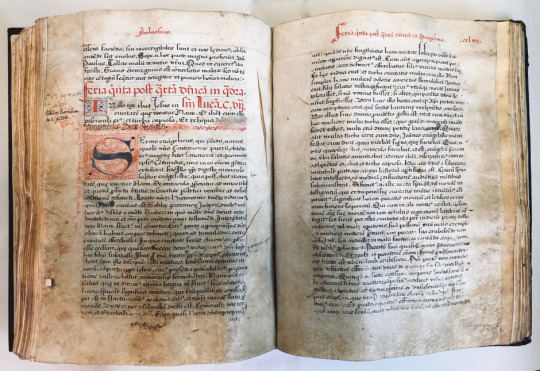
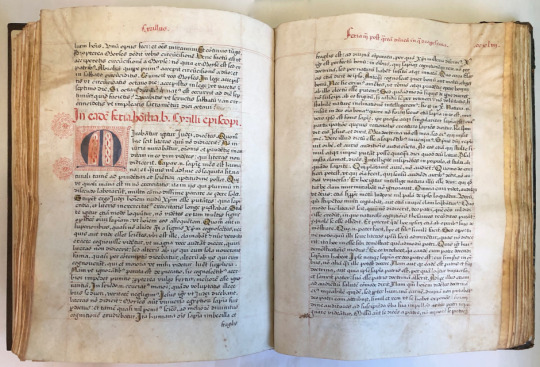


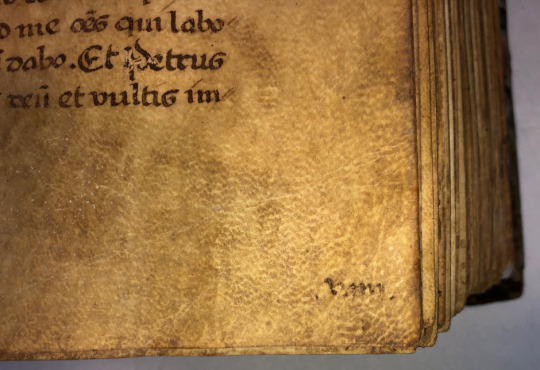
An early fifteenth century manuscript Homiliary 281J Early 15th century Homiliary {Homiliarius doctorum qui omiliarius dici solet ... Hieronymi Augustini, Ambrosii, Jo. Chrysostomi, Gregorii, Origenis, Bede et complures ..}?
#Alcuin#Charlemagne#early 15th century#Homilies#Medieval manuscript#medieval philosophy#St Ambrose#St Augustine#St Bernard#Venerable Bede
0 notes
Photo

population estimates of the German territories range around 5 to 6 million by the end of Henry III’s reign in 1056 and about 7 to 8 million after Friedrich Barabarossa’s rule in 1190.[91][92] The vast majority were farmers, typically in a state of serfdom under feudal lords and monasteries.[76] Towns gradually emerged and in the 12th century many new cities were founded along the trading routes and near imperial strongholds and castles. The towns were subjected to the municipal legal system. Cities such as Cologne, that had acquired the status of Imperial Free Cities, were no longer answerable to the local landlords or bishops, but immediate subjects of the Emperor and enjoyed greater commercial and legal liberties.[93] The towns were ruled by a council of the – usually mercantile – elite, the patricians. Craftsmen formed guilds, governed by strict rules, which sought to obtain control of the towns; a few were open to women. Society had diversified, but was divided into sharply demarcated classes of the clergy, physicians, merchants, various guilds of artisans, unskilled day labourers and peasants. Full citizenship was not available to paupers. Political tensions arose from issues of taxation, public spending, regulation of business, and market supervision, as well as the limits of corporate autonomy.[94] Cologne’s central location on the Rhine river placed it at the intersection of the major trade routes between east and west and was the basis of Cologne’s growth.[95] The economic structures of medieval and early modern Cologne were characterized by the city’s status as a major harbor and transport hub upon the Rhine. It was the seat of an archbishop, under whose patronage the vast Cologne Cathedral was built since 1240. The cathedral houses sacred Christian relics and since it has become a well known pilgrimage destination. By 1288 the city had secured its independence from the archbishop (who relocated to Bonn), and was ruled by its burghers.[96] Towns and cities of the Medieval and Early Modern Holy Roman Empire Cologne, around 1411 Munich, Nuremberg Chronicle, 1493 Regensburg, in 1572 Nordhausen, 17th century Lübeck, 15th century Bamberg, Nuremberg Chronicle, 1493 Women Edit From the early medieval period and continuing through to the 18th century, Germanic law assigned women to a subordinate and dependent position relative to men. Salic (Frankish) law, from which the laws of the German lands would be based, placed women at a disadvantage with regard to property and inheritance rights. Germanic widows required a male guardian to represent them in court. Unlike Anglo-Saxon law or the Visigothic Code, Salic law barred women from royal succession. Social status was based on military and biological roles, a reality demonstrated in rituals associated with newborns, when female infants were given a lesser value than male infants. The use of physical force against wives was condoned until the 18th century in Bavarian law.[97][98] Some women of means asserted their influence during the Middle Ages, typically in royal court or convent settings. Hildegard of Bingen, Gertrude the Great, Elisabeth of Bavaria (1478–1504), and Argula von Grumbach are among the women who pursued independent accomplishments in fields as diverse as medicine, music composition, religious writing, and government and military politics. Learning and culture Edit Benedictine abbess Hildegard von Bingen (1098–1179) wrote several influential theological, botanical, and medicinal texts, as well as letters, liturgical songs, poems, and arguably the oldest surviving morality play, while supervising brilliant miniature Illuminations. About 100 years later, Walther von der Vogelweide (c. 1170 – c. 1230) became the most celebrated of the Middle High German lyric poets. Around 1439, Johannes Gutenberg of Mainz, used movable type printing and issued the Gutenberg Bible. He was the global inventor of the printing press, thereby starting the Printing Revolution. Cheap printed books and pamphlets played central roles for the spread of the Reformation and the Scientific Revolution. Around the transition from the 15th to the 16th century, Albrecht Dürer from Nuremberg established his reputation across Europe as painter, printmaker, mathematician, engraver, and theorist when he was still in his twenties and secured his reputation as one of the most important figures of the Northern Renaissance. The addition Nationis Germanicæ (of German Nation) to the emperor’s title appeared first in the 15th century: in a 1486 law decreed by Frederick III and in 1512 in reference to the Imperial Diet in Cologne by Maximilian I. By then, the emperors had lost their influence in Italy and Burgundy. In 1525, the Heilbronn reform plan – the most advanced document of the German Peasants’ War (Deutscher Bauernkrieg) – referred to the Reich as von Teutscher Nation (of German nation). influential German speaking authors, artists and scholars of the Late Middle Ages and the Renaissance Hildegard von Bingen (1098–1179), Benedictine abbess, philosopher, author, artist and visionary naturalist Walther von der Vogelweide (c. 1170–1230), most celebrated Middle High German language Minnesänger Johannes Gutenberg (c. 1398–1468), pioneering user of the printing press with movable types Albertus Magnus (c. 1193–1280), bishop, philosopher, theologian, Doctor of the Church Georgius Agricola (1494–1555), metallurgist and ‘‘Father of mineralogy’’, author of De Re Metallica Albrecht Dürer (1471–1528), one of the most influential artists of the Northern Renaissance Tilman Riemenschneider (c. 1460–1531), most accomplished sculptor, woodcarver and master in stone from the late Gothic to the Renaissance Early modern Germany 1648–1815 1815–1867 German Empire, 1871–1918 Weimar Republic, 1919–1933 Nazi Germany, 1933–1945 Germany during the Cold War, 1945–1990 http://bit.ly/2JSQHBl
0 notes
Text
The Myth of the Dog-head; what makes a Human?
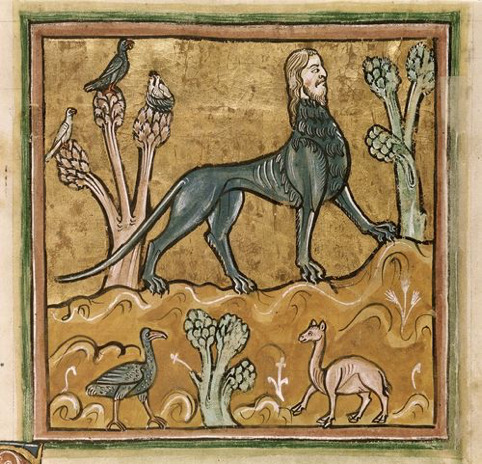
Manicore in the Rochester Bestiary, c. 1230, Royal MS 12 F XIII, f. 24v
Hybridisations comprising elements of human and partially of animal are frequently found in literature, as seen in the representations of monsters such as a harpy (bird of prey with woman’s head), centaurs, manicore (body of a lion with a scorpion stinger and head of a man) and minotaur (head of a bull and the body as man).
The centaur has the body of a horse and from the torso upwards is in human form. With a human head, they retain a capacity for cognition. ��They have the ability to reason. For example, Chiron is the teacher of the great warriors Heracles and Achilles. Although their bestial nature does come to the forefront at times, for instance in the episode of the slaughter by the Centaurs at the Lapith wedding, they are usually depicted as possessing more human qualities than that of a beast.[1] When this is compared to the opposite type of hybridisation, those whose upper body is the beast, the depictions typically show a lack or absence of rational thought. The minotaur of King Minos has a human body and a bull’s head. He is shown to be the opposite of a human. He does not demonstrate a capacity for reasoning and unlike the centaurs, he is isolated, not living in a community. The minotaur has a violent nature and his lack of humanity is further confirmed by his predilection for human flesh.
These hybridisations are also found in the catalogues of monstrous races found commonly in many medieval manuscripts. One such type is the race of the dog-headed people known as the Cynocephali or the dog-milkers, Cynomolgi. Who were this race of dog-heads? The knowledge of such races had been inherited from the Classical tradition. The 5th century BC Greek historian, Herodotus wrote that the Cynocephali inhabited the area west of Libya, along with a menagerie of other monstrous creatures, such as headless men with eyes in their chests.[2] Another Greek historian, Ctesias, writing in the following century, offered one of the most complete descriptions of the early accounts He described the Cynocephali as clothed in animal skin, without language, only conversing through barking or formulating signs with their hands. They ate raw flesh and dwelt in caves of the Indos valley region.[3] Later again, Pliny the Elder writing his Natural History in the 1st century Roman empire, touched on the Cynocephali, noting that they were clothed in animal skin and communicated with each other by barking.[4] These Classical representations conveyed an image of otherness, the image of these beings was constructed in order to be in opposition the image of their own society. What the Greeks and Romans considered the markers of civilisation were reversed and placed upon this mythical race. The Cynocephali existed on the periphery of the known world and their customs were unnatural and contrary to the Greek and Roman traditions. They were shown to be primitive; they ate human flesh and could not converse through human speech. They were beings who shared more characteristics with that of beasts than of humans. This image was carried into the Christian tradition, the Patristic author Augustine drawing much from Pliny’s writings. Although referring to the dog-heads in the City of God, Augustine remains unconvinced of the possible existence of the race, affirming that ‘it is not, of course, necessary to believe in all the kinds of men which are said to exist.’ This deliberation on the Cynocephali arose from the investigation whether or not monstrous races were descended from Adam, ‘the first father of mankind’, a vital question to determine if they were indeed capable of being converted and ultimately have the chance at salvation. Augustine argues that is not the shape, colour or perceived abnormality of the individual which determines their humanity, but instead their capacity for reason, a capacity which could be exhibited through their faculty of speech.[5] It was therefore not the external appearance which was critical but the presence of internal thought. Later in the tradition, Isidore, the bishop of Seville, in his Etymologies, examined portents as those which are ‘contrary to known nature’. He spoke of the Cynocephali as a race of people from India who bark and he recorded the view, stemming from the Augustinian discourse, that the dog-heads did not have the capability to reason based upon this inability to speak. The facility of speech was a crucial factor as the means of expression, but also in process revealing a capacity for thought. This demonstration was considered as evidence of their humanity and as a consequence, an opportunity for proselyting. Likewise, in the text The Wonders of the East, which is found in Old English in the medieval Beowulf manuscript, touches on the race of the Cynocephali. The half-dogs are fantastically described as fire-breathing, having ‘horses’ manes’ and boar tusks. But here their method of communication is not articulated and they were portrayed as living in cities of wealth in Egypt. In the same manuscript, a parallel description of their physical attributes is found in the Book of Monsters and they are said to be more beast than human, in that their speech is interposed with barks and they exist on a diet of flesh.[6]

The subject of the conversion of the Cynocephali arises also in the Contendings of the Apostles, an Ethiopic apocryphal text dealing with the Acts of the Apostles. It was prophesied to Andrew that he and Bartholomew will meet a dog-faced individual on their journey through the eastern region of Parthia and this monster will then aid them with their missionary undertaking of spreading the gospels. The description of the dog-faced creature is comparable to those mentioned above,
‘… his face was like unto the face of a great dog, and his eyes were like unto lamps of fire which burnt brightly, and his teeth were like unto the tusks of a wild boar, or the teeth of a lion… and his whole appearance was awful and terrifying.’
He is portrayed as cannibalistic and he cannot converse in the human tongue. The dog-face introduces himself to the two Apostles as Hasûm, meaning the ‘Abominable’. However, to reflect his new identity, Andrew gives him the new name ‘Christian.’ At the prospect of a possible interaction with the Apostles, the dog-face expressed concern regarding his bestial nature. The angel who visited him told him that through his newly found Christian faith, God would inhibit his bestial urges and alter him to be more human in his nature. His internal disposition was changed, but externally his features remained the same.

Correspondingly, in medieval manuscript illumination, the Cynocephali were depicted in relation to missionary work, as seen in the image above. They were used to represent of one of the races to which the Apostles went on their first missionary endeavour. During Pentecost, after the Holy Spirit gifted the Apostles the ability to speak in every language, they went out to preach the Gospel to the nations. Working off this idea, the 9th century manuscript illuminators depicted the Cynocephali as one such nation among others. The dog-heads were heathen to be converted and at times they could allegorically represent either the Jewish or Islamic peoples. One factor remains consistent in these canid representations, they are repeatedly signifying ‘the other.’ The human/animal relation can be used in the narrative to articulate those communities living on the periphery of the known world. Their animal connection is made to create a representation of ab-normalness, otherness. These monstrous people had different customs and practices than those at the centre, and crucially different from those creating the literature. The contrast which was formed in the opposition in their natures served to define the identity of the author’s society.
Irish Passion of St Christopher
Saints are usually the ones portrayed as encountering monsters, not being represented in the guise of a monster. This is not the case for the early hagiographical accounts of St Christopher. The sources present the saint as a member of the race of dog-headed people and his depiction as such is in part to convey fundamental doctrinal concepts regarding conversion and salvation. The earliest accounts survive in both Greek and Latin and they share a basic common narrative. A flesh-eating cynocephalus from the land of the Chananeans, whose sole manner of communication is akin to that of a dog, is converted to Christianity. He prays to God to be granted the power of speech in order to interpose and convert those who persecute Christians. An angel is sent from God who upon striking Christopher and blowing into his mouth, endows him with the gift of language. In these early renditions, Christopher is also depicted as carrying the child Jesus across a river, an image which endures more prominently in the Western iconography than that of Christopher the dog-head.[7] Christopher undergoes a number of trials before being martyred by the Roman emperor Decius for refusing to sacrifice to the pagan gods. The Irish version of the saint’s life survives in two 15th century manuscripts the Leabhar Breac and Liber Flavus Fergusiorum and it opens as follows:
‘There was a persecution of Christians in time of the emperor Decius, and the holy man Christopher was taken and tortured like the others. Christopher was exceedingly wise, and had observed that the Lord assisted those of the heathen who believed just as much as he assisted Christians. Now this Christopher was one of the Dog-heads, a race that had the heads of dogs and ate human flesh. He meditated much on God, but at that time he could speak only the language of the Dog-heads. When he saw how much the Christians suffered he was indignant and left the city. He began to adore God and prayed. ‘Almighty God,’ he said, ‘give me the gift of speech, open my mouth, and make plain thy might that those who persecute thy people may be converted. An angel of God came to him and said: "God has heard your prayer." The angel raised Christopher from the ground, and struck and blew upon his mouth, and the grace of eloquence was given him as he had desired.’

The image of Christopher as a pagan is illustrated in a similar manner to the other accounts of the Cynocephali. He has long hair, tusk-like teeth and glittering eyes and a cannibalistic nature which disappears after his conversion. The saint is put through a number of tests to demonstrate his faith. Decius has his flesh wrenched with metal hooks, a procedure which Christopher is unfazed by. He considered this as a fleeting corporeal pain when compared to the eternal salvation that awaits him in the afterlife. He is tested for a second time, with the application of burning lamps to his abdomen and in repeating his earlier sentiment regarding the kingdom of heaven, he endeavours to convert the emperor. Women are sent to seduce him, soldiers to intimidate him, but they are all converted to Christianity by Christopher. Decius fruitlessly attempts to burn the saint on a pyre but he remains untouched by the flame and this miracle serves to produce more proselytised.
After this, Christopher rises and addresses the crowd with an allegorical prophecy, ‘I have seen the Master of the City, a tall man and his face beautiful like a ray of sun-light.’ This Master battles a dark figure and triumphs. There is a contrast between the ‘hideous’ countenance of the saint and that of the Master of the City.[8] Nevertheless, this vision reinforces the argument that Christopher had been putting forward throughout. The Master of his vision is God and the City is the kingdom of heaven.[9] The narrative presents these parallel binaries of the mortal and corporal, and the immortal and spiritual. Christopher is unconcerned about what happens to him during his mortal life, for he believes that after death his faith will be rewarded with eternal life in the kingdom of God. The Passion of Christopher extolls this message, and it is reflected metaphorically in Christopher himself. The mortal or the corporal is immaterial; it is the welfare of immortal soul which is foremost and which has the potential to lead to salvation. In the penultimate effort of the emperor to do away with Christopher, he is chained and thrown into a dry well and again he avoids death. He is eventually decapitated, the monstrous element of his physique being finally removed. However, this happens only after he expressed his readiness to join God. In death, in order that he continue aiding the faithful and interceding on their behalf, his remains become recognised as a holy relic.
There is an issue with the image of the dog-headed saint, in the belief that man was created in God’s image.[10] If these deformed races diverge from this human image, can they considered as part of the history of salvation? Christopher’s hagiography represents an inversion of the image of the dog-headed man as the unthinking flesh-eating outsider. As in the discussions by Isidore and Pliny before him, this dog-head would commune through barking instead of the language of men. But like the dog-faced Christian in the Acts of Andrew and Bartholomew, Christopher is spiritually converted and his character is likewise converted to reflect the transformative power of Christianity. Augustine argued that if monstrous person can demonstrate reason, then they must be a descendant of Adam and be of the race of men.
There is a focus on the internal transformation. Physically, Christopher remains as a cynocephalus with long hair and boar tusks, but internally he is altered, an alternation which is primarily expressed through his eloquence.[11] It is articulated in a number other ways also. His internal disposition is peaceful; he is meek and subdued when he is beaten by the emperor’s henchman, Baceus. His anthropophagus nature is reformed and he is able to perform a number of miracles, for example the budding and blossoming of his staff and multiplying food for Decius’ soldiers.[12] His transformation is witnessed in the onomastics. His name has been changed upon religious conversion; Reprobus meaning the ‘condemned’ is transfigured to Christopher, the ‘Christ-bearer’. The rhetoric Christopher chooses to espouse with this new ability was of a Christian nature, reaffirming the internal change. The message that he brings is one that demonstrated the transient nature of this life and the vitality of the eternal life in the Kingdom of God. This message is mirrored in the representation of saint himself; his immortal soul is religiously transformed and therefore saved but his physical body which is transient remains unchanged. Christopher capacity for language, despite his unaltered canine appearance, distinguishes him from a beast and previous depictions of the Cynocephali.[13] In the Passion, emphasis is placed upon his articulacy, which was achieved only through the grace of God. Before his conversion the image of the cynocephalus prevailed; Christopher was differentiated from humanity and the faithful by his canine features, his consumption of human flesh and barking tongue. But after his change in religious identity, he is given the ability of human speech and becomes an agent of conversion. This ability allows him to proselyte and confirms his capacity for cognition and salvation.
This representation of Christopher the dog-head was utilised on a practical basis, as witnessed in the 9th century correspondence between a Benedictine monk from the monastery of Corbie, Ratramnus and a priest, Rimbert who was undertaking missionary activity in Scandinavia. The monk deduced from the varied literary evidence that the Cynocephali could be converted if encountered by the proselytiser. Along with the hagiography of Christopher, he based his view using the additional sources of first hand accounts which described animal-mask-wearing warriors from pagan communities.[14] Also the fact that the Cynocephali lived in communities, wore clothing and practiced agriculture meant that they maintained laws, were modest and demonstrated expertise, all indicating that they were indeed human.[15] Being considered as human, they could take their place in the history of salvation. This treatment is opposed to the perception promoted in the earlier classical texts and image of this monstrous hybrid is salvaged and rehabilitated.

[1] The myths could also have been used as allegory, use of Centauromachy, along with Amazonomachy and Ilioupersis on Parthenon south metopes as commentary on Persian plunder of Athens and its acropolis, see for discussion on this hypothesis see Barringer, Art, Myth and Ritual in Classical Greece, pp. 82- 85.
[2] Herodotus, Histories 4. 191. 3. Also dating earlier, Hesiod writing in the 8-7th centuries BC, referred to the half-dog people, as the Hemikunes, representing them as ‘others’, along with the Macrocephali and the Pygmies, see Catalogues of Women Fragments 40A & 44. Tir otherness. they existed on the periphery of the known world and were oposite in er, existing on the periphery, he no l.
[3] Ctesias, Indica Fragment (summary from Photinus, Myriobiblon 72). The nographic y, only is changedg-headset,'o e animal. The male would typically be isolated from the community, only is changed
[4] Pliny the Elder, Natural History 7. 23, Pliny influenced by lost work of Megasthenes, 4th-3rd centuries BC. See also Bruce, ‘Conversion of the Cynocephali,’ p. 48.
[5] Augustine maintained that God as the Creator does not make errors in his creation, but rather it is a human’s failure to ‘view the whole’, by seeing only the ‘deformity of a part,’ Augustine, City of God, 16. 8.
[6] Liber Monstrorum, 1. 16 & 2.13 in Orchard, Pride and Prodigies, p. 269 & p. 297. Also, in Letters of Alexander to Aristotle which is included in the same manuscript, the Cynocephali are mentioned in during Alexander’s travels through India, see §29, Pride and Prodigies, p. 245. As Orchard discusses, the selection of texts in the manuscript pertains to all things monstrous, whilst the texts of Judith and Christopher concern the monster within, Beowulf, Alexander and Liber Monstrorum deal with the monsters without, pp. 169- 170.
[7] This is the significance of the name Christopher, ‘Christ-bearer’. In the Greek and Latin texts, a type of physical transformation is noted, Christopher is portrayed as a black, terrible pagan, whose skin changes to a milk white when he is baptised by St Babylus in Antioch. See Gordon White, Myths of the Dog-Man, p. 35.
[8] Decius describes Christopher as ‘hideous.’ Fraser (tr.), The Passion of St Christopher, p. 319.
[9] In terms of salvation but also the idea also propagated by Augustine throughout The City of God of the two cities, of man and of God.
[10] Genesis 1. 27.
[11] In the Old English Passion of Christopher which is included in the Beowulf manuscript, a physical transformation may be noted. Christopher’s visage is described as transforming into a blossom upon his death. However, this treatment could be considered as metaphorical.
[12] Biblical parallels in Moses’ staff (Exodus 4.3) and Jesus’ miracles of feeding the multitude (found in all gospels, e.g. John 6. 1-14).
[13] The image of language is crucial in the Christian tradition as a religion of the word and the association is frequently illustrated in the Bible, for example the dispersal of language Tower of Babel and emphasis on logos marking the beginning of Genesis, in the Old Testament and the Apostles receiving Holy Spirit and speaking in tongues in the New Testament.
[14] In this ethnographic misunderstanding, the two traditions meet, the wolf warriors are seen as dog-heads.
[15] Bruce, ‘Hagiography as monstrous ethnography: A note on Ratramnus of Corbie’s letter concerning the conversion of the Cynocephali,’ p. 52 & Friedman, The Monstrous Races, pp. 188-190.
#dogheads#myth#mythology#cynocephali#bible#saint#stchristopher#beowulfmanuscript#medieval#classics#monsters#deformed#abnormal
0 notes
Photo

The Emperor Charles IV in the centre with his sons King Wenceslaus IV of Bohemia, on the left, and Margrave Jobst of Moravia from the Olomouc Law Book, c. 1430
70 notes
·
View notes